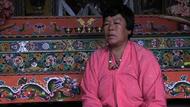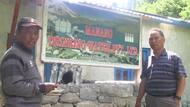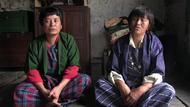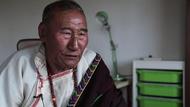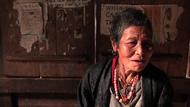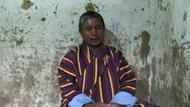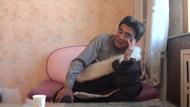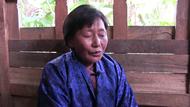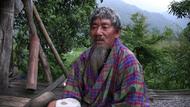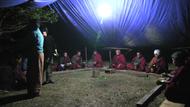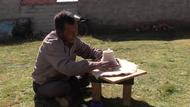Video Overview
Ginger Hunkin, a Chinese medicine specialist, interviews Choeying Phuntsok, a Tibetan doctor, about pulse analysis at UVa's Blake Center.
- Virginia
- ཧན་ཀེན་ Hunkinང་ཚོ་ག་སྒྲིག་ཡིན་ནམ། ཁྱེད་རང་ག་སྒྲིག་ཚར་སོང་ངམ། ལགས་སོ།Are we ready to get, well. Are you ready? Okay.
- དྲི་བ་ལེན་མཁན་ Questionerལགས་འོང་།Yes.
- སྔ་དྲོ་བདེ་ལེགས། ང་ཚོ་ད་ལྟ་ཝི་ཇི་ཉི་ཡ་སློབ་གྲྭ་ཆེན་མོའི་མི་རིགས་ནག་པོའི་ལྟེ་གནས་ཁང་ལ་ཡོད་རེད། ང་འདིར་དེ་རིང་སྔ་དྲོ་སྨན་པ་ཕུན་ཚོགས་མཉམ་དུ་ཡོད། ང་ཚོས་དེ་རིང་རྩ་བརྟག་གི་སྐོར་ལ་དྲི་བ་དྲིས་ལན་བྱེད་ཀྱི་ཡིན།Good morning. We're at the University of Virginia Black Center. And I'm here this morning with Dr. Phuntsok. We're gonna be doing an interview on pulse diagnosis.
- སྨན་པ་ཕུན་ཚོགས་ལགས། ཁྱེད་རང་གིས་ཤར་ཕྱོགས་སྨན་ལུགས་གང་ལག་ལེན་བསྟར་གྱི་ཡོད་དམ།Dr. Phuntsok, which style of oriental medicine do you practice?
- ཕུན་ཚོགས་ Phuntsokབོད་ཀྱི་གསོ་རིགས་ལམ་ལུགས།Tibetan Medicine.
- ཧན་ཀེན་ Hunkinལགས་སོ།Okay.
- ཕུན་ཚོགས་ Phuntsokབོད་ཀྱི་སྲོལ་རྒྱུན་གསོ་བ་རིག་པ།Tibetan Traditional Medicine.
- ཧན་ཀེན་ Hunkinལགས་སོ། ཁྱེད་རང་གི་སློབ་གཉེར་དང་བྱེད་བཟོ་གང་འདྲ་ཡིན་ནམ།All right. And what is your training and style?
- ཕུན་ཚོགས་ Phuntsokང་བོད་ནང་སློབ་སྦྱོང་བྱས་པ་ཡིན། ཐོག་མར་ལོ་གསུམ་དང་། དེ་ནས་རང་ཉིད་ལ་ཆབ་སྲིད་དང་འབྲེལ་བའི་དཀའ་ངལ་འཕྲད་ནས། རྒྱ་གར་ལ་བཙན་བྱོལ་དུ་འགྲོ་དགོས་བྱུང་སོང་། དེ་ནས་བཞུགས་སྒར་རྡ་རམ་སར་བོད་ཀྱི་གསོ་བ་རིག་པའི་སློབ་གཉེར་ལོ་ལྔ་བྱས་ཡིན།I trained in Tibet. Beginning three years. And then I got problem. Because political problem. And then I escaped to India. I studied for five years in India, Dharamsala.
- ཧན་ཀེན་ Hunkinལཱ་སེ།Okay.
- བོད་སྨན་སློབ་སྦྱོང་བྱེད་པའི་སྐབས་ལ། ཁྱེད་ཀྱིས་དམིགས་སུ་བཀར་ནས་སྨན་གྱི་ཆ་ཤས་ཤིག་གི་སྐོར་ལ་སློབ་སྦྱོང་བྱས་ཡོད་དམ། དཔེར་ན་ཨ་རིར་ཆ་མཚོན་ན། སྨན་པ་འགའ་ཤས་ཀྱིས་ནང་གི་གཟུགས་པོའི་ཆ་ཤས་སྐོར་སློབ་སྦྱོང་བྱེད་པ་དང་། ནང་གི་དབང་པོའི་སྨན་བཅོས་ལ་སོགས་པའི་གནས་གང་རུང་ཞིག་ལ་དམིགས་སུ་བཀར་ནས་སློབ་སྦྱོང་བྱེད་ཀྱི་ཡོད།And do you have a focus when you were in school studying the medicine? Like here in the United States, the doctors may focus on internal medicine, oncology, or different area.
- ཕུན་ཚོགས་ Phuntsokལགས་འོ། ཡིན་ནའི་མི་འདྲ། ང་ཚོར་ལམ་ལུགས་མི་འདྲ་བ་ཞིག་ཡོད་པ་དེ་བོད་ཀྱི་སྨན་པ་ཚོས་སློབ་གཉེར་བྱེད་དགོས་ཀྱི་ཡོད། དེའི་ནང་ནང་གི་གཟུགས་པོའི་ཆ་ཤས་གཅིག་པོ་མ་རེད་ལ། གཟུགས་ཕུང་ཆགས་རིམ་སྐོར་ཙམ་མ་རེད། དེ་བཞིན་སྨན་སྦྱོར་རིག་པའི་སྐོར་གཅིག་པུ་མ་རེད། ཚང་མ་སློབ་སྦྱོང་བྱེད་དགོས་ཀྱི་ཡོད།Yes. Then difference. We have a different system, which is Tibetan doctor's to have to study, not only internal. Not only anatomy, not only pharmacology. Have to study everything.
- ཧན་ཀེན་ Hunkinལགས་སོ།Okay.
- ཕུན་ཚོགས་ Phuntsokདེ་དག་སློབ་སྦྱོང་བྱས་ཚར་བའི་རྗེས་སུའང་གནས་གཅིག་ལ་རིགས་གཅིག་རྐང་འཛིན་གྱི་སློབ་སྦྱོང་མེད།So after that there's, even there's no specialization.
- ཧན་ཀེན་ Hunkinཁྱེད་ཀྱིས་སློབ་གཉེར་ཚར་བའི་རྗེས་ལ་རེད་པས།After you finish yours?
- ཕུན་ཚོགས་ Phuntsokལགས་འོང་། ཁྱེད་ཀྱིས་སློབ་སྦྱོང་ཚར་བའི་རྗེས་ལ། ད་དུང་མུ་མཐུད་ནས་དེ་ལས་མང་བ་དང་ཚད་མཚོའི་སློབ་སྦྱོང་བྱ་རྒྱུ་ཡོད།Yeah, after finishing, if you study more then you have more, ah, more, more higher teaching.
- ཧན་ཀེན་ Hunkinལགས་སོ།Okay.
- ཕུན་ཚོགས་ Phuntsokརིགས་གཅིག་རྐང་འཛིན་མེད།There's no specialize.
- ཧན་ཀེན་ Hunkinཁྱེད་ཀྱི་གསོ་རིག་གི་ལག་ལེན་དེ་ཉམས་ལེན་བྱེད་དགོས་དོན་གང་ཡིན་ནམ།And why do you to practice this particular style?
- ཕུན་ཚོགས་ Phuntsokཨོའོ། ངས། གང་འདྲ་སེ་འགྲེལ་བརྗོད་བྱེད་དགོས་སམ། རེད། བོད་ཀྱི་སྨན་པས་རྟག་དཔྱད་འདྲ་མིན་བྱེད་ཀྱི་རེད། དེ་དག་ནང་རྩ་རྟག་དཔྱད་དང་། གཅིན་པ་རྟག་དཔྱད། གདོང་དང་ལུས་ཀྱི་ཡན་ལག་རྟག་དཔྱད། མིག་དང་། ལྕེ། སྣ། ལ་སོགས་པའི་དབང་པོ་རྟག་དཔྱད་དང་། དེ་བཞིན་སྐྲ་མདོག་ལ་སོགས་པ་ལ་རྟག་ཞིབ་གནང་གི་རེད།Oh, I ... practice style. Is a, how can I say? Yeah, Tibetan doctors do the diagnosis. These are, pulse diagnosis, urine analysis, and also see faces and arms whatever, and then eyes and, tongue whatever, nose, hair color, whatever. Skin color and eyebrow whatever. Everything.
- ཧན་ཀེན་ Hunkinལཱ་སེ།Uh-huh.
- ཕུན་ཚོགས་ Phuntsokའོན་ཀྱང་། གཅིན་པ་རྟག་དཔྱད་དང་རྩ་བརྟག་གཉིས་ནི་གཙོ་བོ་རེད།But main diagnosis is urine analysis and pulse diagnosis.
- ཧན་ཀེན་ Hunkinཁྱེད་ལ་དབྱིངས་སླེབས་དགོས་དོན་གང་ཡིན་ནམ།What attracted you to this particular style?
- དྲི་བ་ལེན་མཁན་ Questionerདྲི་བ་དེ་གང་ཟེར་གྱི་ཡོད་རེད་ཟེར་ན། ཁྱེད་ཀྱིས་ཕྱི་ལུགས་སྨན་གྱི་སློབ་སྦྱོང་ཚབ་ཏུ་བོད་ལུགས་གསོ་རིག་འདམ་ག་བྱེད་དགོས་དོན་གང་རེད།Means why did you choose Tibetan medicine and not western medicines?
- ཧན་ཀེན་ Hunkinཡང་ན་ཨཱ་ཡུ་ལྦེ་ཌིགOr Ayurveda, yeah.
- ཕུན་ཚོགས་ Phuntsokརྒྱུ་མཚན་དང་པོ་དེ་གང་རེད་ཟེར་ན། ངའི་གནས་སྟངས་ངོས་ནས་བཤད་ན། ང་བྱིས་པའི་སྐབས་སུ་ཚེ་རབས་ལས་རྩིས་བསྐོར་ཡོད།That is we, number one, my situation is when I was a small kid, we do a horoscope, horoscope.
- ཧན་ཀེན་ Hunkinལཱ་སེ།Uh-huh.
- ཕུན་ཚོགས་ Phuntsokདེའི་ནང་ང་གྲྭ་པ་བྱེད་དགོས་གསུངས་ཡོད།Says that I supposed to be a monk.
- ཧན་ཀེན་ Hunkinལཱ་སེ།Uh-huh.
- ཕུན་ཚོགས་ Phuntsokགང་ཡིན་ཟེར་ན། དེ་ལྟར་མ་བྱས་ན་མི་ཚེའི་ནང་ལ་བར་ཆད་ཡོང་གི་རེད་ཞེས་བཤད་ཡོད། ང་གྲྭ་པ་བྱེད་ཐུབ་མེད་པས་བྱས་ཙང་འདམ་ག་གཉིས་པ་ཞིག་ཡོད་རེད། ངས་ཤེས་བྱ་གང་རུང་ཞིག་སྦྱངས་ནས་མི་གཞན་ལ་ཕན་ཐོགས་བྱེད་རྒྱུ་དེ་རེད།Because otherwise post I will have a big problem in life. Says that. And then I couldn't be that so there is a second choice. You need to learn something, help people.
- བོད་ནང་དུ་འདམ་ག་གཞན་མེད། གང་ཡིན་ཟེར་ན་རྒྱ་གཞུང་དང་འབྲེལ་བ་ཡག་པོ་མེད། བྱས་ཙང་ངས་བོད་སྨན་སློབ་སྦྱོང་བྱས་པ་ཡིན།So then in Tibet, there's no other choice. Even then we are not good with the Chinese government. So I just learned Tibetan medicine.
- ཧན་ཀེན་ Hunkinལགས་སོ།Okay.
- ཕུན་ཚོགས་ Phuntsokང་ལ་འདམ་ག་གཞན་མེད་པས། བྱས་ཙང་ངས་བོད་སྨན་སློབ་སྦྱོང་བྱས་པ་ཡིན།I have no choice do another thing. So I did that.
- ཧན་ཀེན་ Hunkinཁྱེད་ཀྱིས་དགེ་རྒན་སུ་སུ་བསྟེན་ཡོད་དམ།And who were your teachers?
- ཕུན་ཚོགས་ Phuntsokངའི་དགེ་རྒན་དང་པོ་དེ་ནི་ངའི་ཨ་ཞང་རེད། ཁོང་ང་ཚོའི་ལུང་པའི་ནང་སྐད་གྲགས་ཡོད་པའི་སྨན་པ་ཞིག་རེད།My first teacher in Tibet, my uncle. He's a great Tibetan doctor in my hometown.
- ཧན་ཀེན་ Hunkinལགས་སོ།Uh-huh.
- ཕུན་ཚོགས་ Phuntsokཁོང་གི་མཚན་ལ་ཡེ་ཤེས་ཟེར་གྱི་ཡོད། དེ་ནས་ང་ལ་ཡང་དགེ་རྒན་གཞན་ཞིག་ཡོད། དེ་ནི་དགེ་རྒན་གཉིས་པ་དེ་རེད། ཁོང་གི་མཚན་ལ་མཆི་མེད་རྒྱལ་མཚན་ཟེར་གྱི་ཡོད། ཁོང་ནི་བསྟན་འཛིན་རིན་པོ་ཆེའི་ཕལ་ཆེར་ཨ་ཞང་རེད། ཁོང་ནི་བོན་གྱི་སྲོལ་རྒྱུན་སྨན་པ་ཞིག་རེད།His name is Yeshi. And then there is another teacher too. That is my second teacher. He is Chemi Gyaltsen, which (who) is Tenzin Rinpoche's maybe uncle. He is a Bön traditional doctor.
- ཧན་ཀེན་ Hunkinཁྱེད་ཀྱི་དགེ་རྒན་དང་པོ་སྟེ། ཁྱེད་ཀྱི་ཨ་ཞང་ལགས་དང་མཉམ་དུ་ཁྱེད་ཀྱིས་ལོ་ག་ཚོད་རིང་ལ་ཁོང་དུ་དྲུང་དུ་སློབ་སྦྱོང་བྱས་ཡོད་དམ། དེ་གང་འདྲ་བྱས་ནས་འགོ་ཚུགས་བྱས་ཡོད། བརྒྱུད་རིམ་ཞིག་གསུང་རོགས་གནང་།So with your first teacher, with your uncle, how many years did you work with him? Can you tell me how that started, you know, how you started that process?
- ཕུན་ཚོགས་ Phuntsokཨཱ། ངས་བོད་སྨན་སློབ་སྦྱོང་མ་བྱས་སྔོན་ལ་ངས་རང་གི་ཨ་ཞང་མཉམ་དུ་བོད་ཀྱི་སྐད་ཡིག་སློབ་སྦྱོང་བྱས་པ་ཡིན། ངའི་བསམ་པར་ཕལ་ཆེར་ལོ་གཅིག་གམ་གཉིས་ཙམ་རིང་བོད་ཡིག་སློབ་སྦྱོང་བྱས། གང་ཡིན་ཟེར་ན་དེ་དུས་ང་ལོ་ཆུང་ཆུང་རེད།Uh, I learned Tibetan medicine in, before that time, I studied with my uncle Tibetan language. I think a year or two years something like that. Since that time I was young.
- དེའི་རྗེས་ལ་ཨ་ཞང་གིས་ང་ཁོང་དང་མཉམ་དུ་ཁྲིད་ནས་སྨན་རྩ་བརྐོ་བ་དང་། སྨན་བཟོ་བ་སོགས་གནང་གི་ཡོད། ཁོང་རང་ཉིད་ཀྱི་སྨན་བཟོ་ས་ཞིག་ཡོད། དེ་བཞིན་ཁོང་གིས་ང་ལ་སྨན་གཞུང་སློབ་ཁྲིད་གནང་། དེའི་མིང་ལ། གསོ་རིག་ཟིན་བྲིས་ཆེད་བསྡུས། ཟེར་གྱི་ཡོད།And after that, my uncle brings me, collected herbs, and also making herbs like it. There is his own pharmacy is there. And then, by the way, he teaches me the textbook, and the name is Zindri Chédü, Sorik Zindri Chédü (Compilation of Medical Notes).
- དེ་ནི་ང་ཚོར་ཡོད་པའི་རྒྱུད་བཞི་མ་རེད། གཞུང་དེའི་ནང་དུ་ཆོས་ཀྱི་གནད་དོན་རིགས་གང་ཡང་མེད། གང་ལགས་ཟེར་ན། རྒྱ་གཞུང་གིས་ནང་དོན་དེ་རིགས་མེད་པ་བཟོས་ཡོད། བྱས་ཙང་ནས་ཐོག་མར་རྩ་དཔྱད་སྦྱངས་པ་ཡིན། ཁོང་ཚོས་རྩ་དཔྱད་དང་གཅིན་པ་རྟག་དཔྱད་སློབ་ཁྲིད་བྱེད་ཀྱི་ཡོད།That is not our Four Tantras that is there. Inside not religious thing, because the government took out. So I learned that first pulse diagnosis. They are teaching pulse diagnosis and urine analysis.
- ཁོང་ཚོས་སློབ་ཁྲིད་མ་བྱས་སྔོན་ནས་ངས་རྩ་དཔྱད་དང་། གཅིན་པ་རྟག་དཔྱད་ཀྱི་གཞུང་དེ་དག་བློ་འཛིན་བྱེད་དགོས་ཀྱི་ཡོད། ངས་དེ་ཕལ་ཆེར་ལོ་གཅིག་ཙམ་རིང་སློབ་སྦྱོང་བྱས་པ་ཡིན། དེའི་རྗེས་ལ་ཁོང་གིས་ང་ལ་ལོ་གཅིག་གམ་ཡང་ན་གཉིས་ཀྱི་རིང་ལ་སློབ་ཁྲིད་གནང་། ཕལ་ཆེ་བ་ལས་ཀ་བྱེད་རྒྱུ་རེད། དེ་ནི་གཙོ་བོ་སྨན་བཟོ་རྒྱུ་དེ་རེད། དེ་རྗེས་ང་ལ་རྒྱ་གཞུང་གི་དཀའ་ངལ་འོག་ལ་ཚུད།And before they teach, I need to memorize pulse diagnosis and urine analysis. I did that I think a year. And after that he teach me for another two years. And mostly work. Make pharmacy, pills like these things. And then some problem with the Chinese government.
- ཧན་ཀེན་ Hunkinཁྱེད་ཨ་ཞང་མཉམ་དུ་ལས་ཀ་བྱེད་དུས་ཁྱེད་རང་དེ་དུས་ལོ་ག་ཚོད་རེད་དམ།How old are you when you started working with your uncle?
- ཕུན་ཚོགས་ Phuntsokལོ་གཉིས།Two years.
- ཧན་ཀེན་ Hunkinཁྱེད་རང་ལོ་གཉིས་རེད་པས།You were two years old?
- ཕུན་ཚོགས་ Phuntsokཨོའོ།Oh.
- ཧན་ཀེན་ Hunkinསྨན་གྱི་སློབ་སྦྱོང་ཆེད་དུ་ཁྱེད་ཀྱིས་སྐད་ཡིག་སློབ་སྦྱོང་བྱེད་དུས་ཁྱེད་རང་ལོ་ག་ཚོད་རེད་དམ།How old were you when you started learning language for the medicine?
- ཕུན་ཚོགས་ Phuntsokང་དེ་དུས་ལོ་བཅོ་ལྔ་ལ་སླེབས་ཡོད།I was fifteen years old.
- ཧན་ཀེན་ Hunkinལགས་སོ། བྱས་ན་ཕལ་ཆེ་བ་ངག་རྒྱུན་གྱི་ཐོག་ནས་སློབ་ཁྲིད་བྱས་པའི་སྨན་ལུགས་རེད་དམ། ངག་ཐོག་ནས་ཚིག་གཞན་ཐོག་མར་གསུངས་པ་ཞིག་རེད་དམ། གོང་དུ་ཁྱེད་ཀྱིས་དཔེ་ཆ་ཞིག་ཡོད་རེད་གསུངས་སོང་། གཞུང་དེ་བོད་ཀྱི་གསོ་རིག་གི་ཚད་ལྡན་གྱི་གཞུང་ཞིག་རེད་དམ།Okay. So was most of them is oral traditional medicines? Were most of them orally translated in another word? You said you had a textbook. Is it a classic in Tibetan Medicine?
- ཕུན་ཚོགས་ Phuntsokརེད། ཡིན་ནའི་དེ་རྒྱུད་བཞི་མ་རེད། བོད་ཀྱི་ཤར་ཕྱོགས་སུ་སྔ་མོའི་དུས་སུ་གྲགས་ཅན་གྱི་བླ་མ་སི་ཏུ་རིན་པོ་ཆེ་ཞུ་བ་ཞིག་ཡོད། ཁོང་ནི་སྙན་གྲགས་ཅན་གྱི་སྨན་པ་ཞིག་ཀྱང་རེད། ཁོང་ལོ་སྟོང་ཕྲག་གཅིག་གི་གོང་ལ་བྱུང་བའི་བླ་མ་ཞིག་རེད། རེད། ལོ་སྟོང་ཕྲག་གཅིག་གི་གོང་ལ་རེད། ཁོང་གིས་རང་ཉིད་ཀྱི་སྨན་གཞུང་ཞིག་ལྗགས་རྩོམ་གནང་ཡོད།Yes that is not root tantra, root Four Tantras. That is, yeah. In Tibet, eastern Tibet, there is a um, in the ancient time great Sidu Rinpoche. He made, uh, he was a famous doctor since ninety, not ninety. Since one thousand, I think one thousand years. Yeah, one thousand years and he made his own textbook.
- སྨན་གཞུང་དེ་གཞི་བཅོལ་ས་ནི་རྒྱུད་བཞི་རེད། ཁོང་གིས་རང་ཉིད་ཀྱི་སྨན་གཞུང་གསར་པ་ཞིག་ལྗགས་རྩོམ་གནང་ཡོད། སྐབས་དེ་དུས་དེའི་ནང་དུ་ཟིན་བྲིས་ཆེད་བསྡུས་ནང་དུ་ཆོས་ཀྱི་ཆ་མང་པོ་ཡོད། འོན་ཀྱང་རིག་གནས་གསར་བརྗེའི་སྐབས་ལ་ཆོས་ཀྱི་ཆ་ཤས་ཆ་ཚང་མེད་པ་བཟོས་ཡོད། ལྷག་མ་སྨན་བཅོས་དང་འབྲེལ་བའི་ཆ་ཤས་མ་གཏོགས་བཞག་མེད།And the base is Four Tantras. He made, you know, separate new one. And, during that time, in the Zindri Chédü has the religious things. But then after that, after the Cultural Revolution, they took out the religious things. Everything, just a few of only techniques. Technicians.
- ཧན་ཀེན་ Hunkinལཱ་སེ།Uh-huh.
- ཕུན་ཚོགས་ Phuntsokདེ་མིན་གཞན་དག་མེད།Otherwise there is nothing.
- ཧན་ཀེན་ Hunkinཁྱེད་ཀྱི་ཨ་ཞང་གི་ངོས་ནས་གཞུང་དེའི་ནང་དུ་ཡོད་པའི་ཆོས་ཀྱི་ཆ་ཤས་རྣམས་མེད་པ་བཟོས་ཡོད་ཀྱང་ཁྱེད་ལ་སློབ་ཁྲིད་གནང་ཡོད་དམ།Um, did your uncle passed on you the spiritual part of the medicinal, even though it wasn't in that textbook?
- ཕུན་ཚོགས་ Phuntsokའོ། ངའི་ཨ་ཤང་ལགས་ཁོང་སྨན་པ་ཞིག་ཡིན་པ་མ་ཟད་ཁོང་དགེ་འདུན་པ་ཞིག་ཀྱང་རེད། ཁོང་གིས་ང་མ་བོད་སྨན་སློབ་ཁྲིད་གནང་བ་ཙམ་མ་ཟད། ཉིན་མ་གཅིག་པ་ཕལ་ཆེར་ཆུ་ཚོད་གཅིག་ཙམ་གྱི་རིང་ལ་སྨན་བཟོ་བ་དང་། དེ་དུས་འཕྲུལ་ཆས་རིགས་མེད་པ་ཁྱེད་ཀྱིས་མཁྱེན་གསལ་ལྟར་རེད། བྱས་ཙང་ཁྱེད་ཀྱིས་ལག་པས་བརྡུངས་ཞིབ་ཞིབ་བཟོ་བ་སོགས་བྱས་ནས་བཟོ་དགོས་ཀྱི་ཡོད།Yeah, my uncle, actually my uncle was not only doctor, he is a monk. And he teach me not only medicine. Once a day, I think you have spent there. One hour or so. We make pill, you know, grind and not there is no machines. You have to make, and also you know.
- དེ་དུས་ངའི་ཨ་ཞང་གིས་མཉམ་དུ་སྨན་འཚག་པ་ལ་སོགས་བྱེད་པ་དང་། ང་ཚོ་སློབ་ཕྲུག་གསུམ་ལ་སྨན་གྱི་སློབ་ཁྲིད་གནང་གི་ཡོད། ངས་དྲན་གསོས་པ་ཞིག་ནི་གུ་རུ་རིན་པོ་ཆེའི་ལོ་རྒྱུས་རེད།And during that time, my uncle also, you know sieve, sieve the herbs. And by the way, he teach us. We have three students, teach us. First I remember Guru Rinpoche's history.
- དེ་ཕལ་ཆེར་ཟླ་བ་གསུམ་གྱི་ནང་ལ་ཚར་སོང་། དེའི་རྗེས་ལ་ཁོང་གིས་ང་ཚོར་སྟོན་པ་ཤཱཀྱ་ཐུབ་པའི་མཛད་རྣམ་སྐོར་གསུངས་གནང་བྱུང་།And then the finishing, I think in three months. And after that, he teach, teach us Buddha's story.
- ཧན་ཀེན་ Hunkinལཱ་སེ།Uh-huh.
- ཕུན་ཚོགས་ Phuntsokདེ་ནི་ཉིན་མ་རེར་ཆུ་ཚོད་རེ་དང་། དེ་ནས་ཉིང་གུང་གི་དུས་སུ་ཆུ་ཚོད་གཅིག་གམ་གཉིས། སྐབས་རེ་ཆུ་ཚོད་གསུམ་གྱི་རིང་ལ་ཁོང་གིས་ང་ཚོར་བོད་སྨན་སློབ་ཁྲིད་གནང་གི་ཡོད། དཔེར་ན་རྩ་དཔྱད་ལ་སོགས་པ།Just one hour, one hour, once a day. And then, after that, like an afternoon, I think one or two hours, sometimes three hours, sometimes one hour. He teaching Tibetan medicine, how to pulse diagnosis, these things.
- ཡང་སྐབས་རེ་ཁོང་གིས་བོད་ཀྱི་སྨན་པ་གྲགས་ཅན་གྱི་ལོ་རྒྱུས་གསུངས་གནང་གི་ཡོད།And sometimes he teach us Tibetan, famous doctors' histories.
- ཧན་ཀེན་ Hunkinལཱ་སེ།Uh-huh.
- ཕུན་ཚོགས་ Phuntsokགཡུ་ཐོག་གསར་མ་དང་རྙིང་མའི་སྐོར་དང་། སྡེ་སྲིད་སངས་རྒྱས་རྒྱ་མཚོའི་རྣམ་ཐར་ལ་སོགས་པ་ལྟ་བུ། བོད་ནང་དུ་གྲགས་ཅན་སྨན་པ་མང་པོ་ཡོད།And Yutok, and Yutok Sarma and Nyingma. Dési Sang gyé. There are many famous doctors.
- ཧན་ཀེན་ Hunkinཁྱེད་རང་གི་དགེ་རྒན་གཉིས་པའི་དྲུང་ནས་སློབ་སྦྱོང་བྱེད་པའི་ཆེད་དུ་ཁྱེད་ཀྱིས་ཁོང་གི་གནས་སུ་བསྐྱོད་ནས་སློབ་སྦྱོང་བྱེད་ཀྱི་ཡོད་དམ། ཡང་ན་ཁོང་ཁྱེད་རང་གནས་ཡུལ་གྲོང་རྡལ་དུ་ཡོད།Your second teacher, did you go somewhere to study with him or was he also in your same town?
- ཕུན་ཚོགས་ Phuntsokགྲོང་རྡལ་གཅིག་པ་རེད།Same town.
- ཧན་ཀེན་ Hunkinལགས་སོ། ཁོང་དང་ཁྱེད་འབྲེལ་བ་དེ་ཐོག་མར་གང་འདྲ་སེ་བྱས་ནས་བྱུང་བ་རེད།Okay. And how did you connect up with that teacher?
- ཕུན་ཚོགས་ Phuntsokངའི་ཨ་ཞང་ང་དང་མཉམ་དུ་བཞུགས་ཀྱི་ཡོད། ངའི་ཕ་མ་དང་མཉམ་དུ། ང་ཚོའི་ལུང་པའི་ནང་ལ་བུ་སྤུན་རྣམས་ཁྱིམ་ཚང་དུ་བསྡད་པ་དང་། བུ་མོ་ཁྱིམ་ནས་ཐོན་གྱི་ཡོད། སྐྱེས་པ་གཞང་དང་གཉེན་སྒྲིག་བྱས་ནས།Ah, my uncle lived with me. Live with my parents. Because our country, people, brother or whatever, sister never live at home. They go to marry another like a guy.
- བུ་སྤུན་རྣམས་མཉམ་དུ་བསྡད་པ་དང་། སྐབས་རེ་བུ་སྤུན་གཉིས་གསུམ་གྱིས་སྐྱེས་དམན་གཅིག་ལེན་གྱི་ཡོད། ཡིན་ནའང་ངའི་ཨ་ཞང་ཁོང་ནི་གྲྭ་པ་རེད། ཁོང་ཆང་ས་རྒྱག་མྱོང་མེད།And brothers live together and then some time two brothers, three brothers, marry one woman, like that. But my uncle was a monk, he never married.
- ཁོང་ང་ཚོ་དང་མཉམ་དུ་བཞུགས་སྔོན་ལ། དེ་ཡང་༡༩༥༩སྔོན་ལ་ཁོང་དགོན་པར་བཞུགས་ཀྱི་ཡོད། དེ་ནས་ཁྱེད་ཀྱིས་མཁྱེན་གསལ་སྔར་གྲྭ་སར་སྡོད་འཇུག་མེད་པས། ཁོང་ཁྱིམ་དུ་བསྐྱར་ལོག་གནང་ནས་ང་ཚོ་དང་མཉམ་དུ་བཞུགས།And but still living at home because, before he lives, since before, before 1959, he lived in the monastery. And then, you know, not allowed to live there and then he came back. Lived with us.
- བྱས་ཙང་ཁོང་གིས་བོད་སྨན་ཉམས་ལེན་གནང་བ་དང་ཆབས་ཅིག་ཏུ་སློབ་ཕྲུག་ལ་སློབ་སྟོན་ཡང་གནང་།So he practiced these things and teach another thing, and students too.
- ཧན་ཀེན་ Hunkinཁྱེད་ཀྱི་ཨ་ཞང་ལགས་ཀྱི་དགེ་རྒན་སུ་རེད་དམ།Who was your uncle's teacher?
- ཕུན་ཚོགས་ Phuntsokངའི་ཨ་ཞང་གི་རྒན་ལགས་ཁོང་ནི་ས་སྐྱ་ནས་རེད། བོད་ཀྱི་ནང་ཆོས་ནང་ཆོས་ལུགས་ཆེན་པོ་བཞི་ཡོད། བྱས་ཙང་ས་སྐྱ་ནི་དེའི་ནང་ནས་གཅིག་རེད། ཁོང་གི་མཚན་ལ་མཁྱེན་བརྩེ་རིན་པོ་ཆེ། མཚན་ཆ་ཚང་ལ་འཇམ་དབྱངས་མཁྱེན་བརྩེ་རིན་པོ་ཆེ་ཞུ་གི་ཡོད། ཁོང་ངའི་ཨ་ཞང་གི་རྒན་ལགས་རེད།My uncle's teacher was a Sakya, another sect, like Sakya. Sakya. There is a Tibetan Buddhism has four different sects. So Sakya, Sakya sect, there is a famous, Khyentsé Rinpoché. Jamyang Khyentsé Rinpoché. He was his (uncle) teacher.
- ཧན་ཀེན་ Hunkinལཱ་སེ།Uh-huh.
- ཕུན་ཚོགས་ Phuntsokཁོང་ལ་ད་དུང་དགེ་རྒན་གཞན་ཞིག་ཡོད། ཁྱོན་དགེ་རྒན་གཉིས་ཡོད། འོན་ཀྱང་གཙོ་བོ་དེ་ནི་འཇམ་དབྱངས་མཁྱེན་བརྩེ་རིན་པོ་ཆེ་རེད།He has another teacher, two. His main teacher was Jamyang Khyentsé Rinpoché.
- ཧན་ཀེན་ Hunkinཁྱེད་རང་དགེ་རྒན་གཉིས་པ་ཞིག་ཡོད་རེད་པ། ཁོང་གི་དྲུང་དུ་ཁྱེད་ཀྱི་ཨ་ཞང་གིས་ཁྱེད་བཏང་བ་རེད་དམ། ཡང་ན་གང་འདྲ་སེ་རེད། ཁྱེད་ཀྱིས་ཁོང་གང་འདྲ་བྱས་ནས་རྙེད་ཐུབ་ཡོད་དམ། ཡང་ན་ཁོང་གིས་ཁྱེད་རང་རྙེད་ནས་ཁྱེད་ཀྱིས་བོད་སྨན་སློབ་སྦྱོང་གི་གནས་རིམ་གཉིས་འགྲོ་ཐུབ་པ་བྱུང་ཡོད་དམ།And the second teacher that you have, how did you, did your uncle sent you to him? How did you find him or how he find you to go to your next stage of medical training?
- ཕུན་ཚོགས་ Phuntsokཁྱེད་ཀྱིས་ཟེར་ན།You mean?
- ཧན་ཀེན་ Hunkinཁྱེད་རང་གིས་ཁྱེད་ལ་དགེ་རྒན་གཉིས་ཡོད་གསུངས་སོང་། དགེ་རྒན་དང་པོ་དེ་ཁྱེད་ཀྱི་ཨ་ཞང་དང་དེ་ནས་དགེ་རྒན་གཞན་ཞིགYou said that you have two teachers. First your uncle and another teacher.
- ཕུན་ཚོགས་ Phuntsokཨོའོ། དགེ་རྒན་གཞན་པ་དེ།Oh, other teachers?
- ཧན་ཀེན་ Hunkinདགེ་རྒན་གཞན་པ་དེ།Other teachers.
- ཕུན་ཚོགས་ Phuntsokདགེ་རྒན་གཉིས་པ་དེའི་མཚན་ལ་དབང་རྒྱལ་ཞུ་གི་ཡོད། ཁོང་ནི་བོན་གྱི་སྨན་པ་གྲགས་ཅན་ཞིག་རེད། ཁོང་ང་ཚོ་དང་མཉམ་དུ་ཕྱག་ལས་གནང་ཡོད། གང་ཡིན་ཟེར་ན། རྒྱ་གཞུང་གིས་ལས་འཆར་གསར་པ་མཉམ་སྟོན་སྨན་ཁང་ཟེར་བ་ཞིག་འགོ་ཚུགས་བྱས་ཡོད།Other teachers, his teacher was there is, Wang gyel. One Bön traditional great doctor. He's his (uncle) teacher. So because he worked with us and the Chinese, they made a new program, there's uh, Nyamtön Menkhang.
- སྨན་པ་དེ་ཚོ་ལ་མིང་ཞིག་ཡོད་རེད། དེ་ནི་ཕྱི་སྐྱོད་ཡི་ཧྲང་(རྒྱ་སྐད་བོད་སྐད་ནང་སྨན་པ་) དེ་ནི་བོད་སྐད་ནང་དུ་སྨན་པ་རྐང་རྗེན་མ་ཟེར་གྱི་ཡོད། དེ་ནི་ཁོང་ཚོས་བཤད་ཡག་གི་ལྷམ་མེད་པའི་སྨན་པ་རྐང་རྗེན་མ་ཟེར་གྱི་ཡོད།There is, the doctors are, called the name, Chikyö Yihrang (barefoot doctors), which is Menpa Kangjenma which is like a, they said, you know, without shoes.
- ཧན་ཀེན་ Hunkinསྨན་པ་རྐང་རྗེན་མ།Barefoot doctors.
- ཕུན་ཚོགས་ Phuntsokལཱ་སེ།Uh-huh.
- ཧན་ཀེན་ Hunkinལཱ་སེ།Yeah.
- ཕུན་ཚོགས་ Phuntsokཁོང་ཚོས་དེ་ལྟར་ལབ་གྱི་ཡོད། ང་ཚོ་མཉམ་དུ་བསྡད་ནས་ལས་ཀ་བྱེད་ཀྱི་ཡོད། ཁོང་ཚོ་མཉམ་དུ་ལས་བྱེད་ཀྱི་ཡོད། ངས་སློབ་སྦྱོང་བྱེད་དུས། ཁོང་ངའི་དགེ་རྒན་རེད།They said that, so we live and work together. And then they work together. When I study, he was my teacher too.
- ཧན་ཀེན་ Hunkinལགས་སོ།Okay.
- ཕུན་ཚོགས་ Phuntsokའོ།Yeah.
- ཧན་ཀེན་ Hunkinཁྱེད་ཀྱིས་ལག་བསྟར་བྱས་པའི་བོད་ཀྱི་སྨན་ལུགས་དེ་ཁྱེད་ལ་ཐོག་མར་ངོ་སྤྲོད་གནང་དུས་ཡང་ན་སློབ་སྦྱོང་བྱེད་དུས་དང་ད་ལྟ་བར་ལ་འགྱུར་ལྡོག་གང་སོང་ཡོད་དམ། ཚིག་གཞན་ཞིག་བེད་སྤྱོད་བྱས་པ་ཡིན་ན།In that particular style or the way that you practice, how has that changed since you were first introduced to it or you first learned it? In other words,
- དྲི་བ་ལེན་མཁན་ Questionerབོད་ཀྱི་གསོ་རིག་ལ་ཁྱེད་ཆུང་ཆུང་སྐབས་ནས་ད་ལྟའི་བར་ལ་འགྱུར་ལྡོག་གང་བྱུང་ཡོད།How does Tibetan medicine change when you were small until now?
- ཕུན་ཚོགས་ Phuntsokཨོའོ། ངའི་མི་ཚེའི་ནང་ལ་འགྱུར་ལྡོག་ཆེན་པོ་བྱུང་ཡོད། འགྱུར་ལྡོག་མང་པ་ཡོད། ངའི་ཕ་ཡུལ་ལ་སྨན་རིལ་བུ་དེ་ཙམ་མང་པོ་བཟོ་གི་མེད། ཁོང་ཚོས་ཞིབ་ཞིབ་བཟོ་གི་ཡོད། དེ་ཡང་དེ་ཙམ་མང་པོ་བཟོ་གི་མེད། ནད་པ་ཚོར་རྟག་དཔྱད་བྱས་ནས་དེ་རྗེས་སྨན་གྱི་ཕྱེ་མ་བཟོས་ནས་ཁོང་ཚོར་སྤྲོད་ཀྱི་ཡོད།Oh, change, in my life changed a lot. Changed a lot. Actually, in my hometown, they don't make too many pills. They only make powder. And the powder not really lot. See patient and then make powder and then give them.
- ནད་པ་རེ་རེར་ལ་སྨན་སྦྱོར་མི་འདྲ་བ་ཞིག་དགོས་ཡོད། རྒྱུ་མཚན་དེ་ལ་བརྟེན་ནས་མང་པོ་བཟོ་གི་མེད། དེ་ནས་ནད་པ་ལ་རྟག་དཔྱད་བྱས་ནས་སྨན་བཅོས་བྱེད་དུས་ཆ་སྙོམ་པོ་ཡོང་བ་བྱེད་ཀྱི་ཡོད།Then don't make, every individual patient need a different formula. So that's why they don't make. And then, they also, when see patient, there is treatment. Making balance.
- Whatever treatment has a stage. First stage and second stage, third stage like that. You know, steps, step by step. And then, I back, I came to India. Then changed a lot. Because they making pills, every. Every medicine, ever herbs. Making pills. Because powder can't live longer.སྨན་བཅོས་རིགས་གང་འདྲི་ཞིག་ཡིན་ཡང་རིམ་པ་བྱས་ནས་འགྲོ་དགོས་ཀྱི་ཡོད། རིམ་པ་དང་པོ་དང་། རིམ་པ་གཉིས་པ། རིམ་པ་གསུམ་པ་སེ་བྱས་ནས་འགྲོ་དགོས་ཀྱི་ཡོད། ཁྱེད་ཀྱིས་མཁྱེན་གསལ་རེད། དེ་ནས་ང་རྒྱ་གར་ལ་སླེབས་རྗེས་འགྱུར་ལྡོག་ཆེན་པོ་བྱུང་སོང་། གང་ཡིན་ཟེར་ན་ཁོང་ཚོས་སྨན་ཚང་མའི་རིལ་བུ་བཟོ་གི་ཡོད། གང་ཡིན་ཟེར་ན་ཞིབ་ཞིབ་ཡིན་ན་ཡུན་རིང་པོར་གནས་ཐུབ་ཀྱི་མེད།
- དེ་ནས་རིལ་བུ་ཕོན་ཆེན་པོ་བཟོ་དགོས་ཀྱི་ཡོད་པ་དང་། གང་ཡིན་ཟེར་ན་སྨན་ཁང་གི་ཡན་ལག་མང་པོ་ཡོད། དེ་འདྲ་སོང་ཙང་སྨན་རྩ་ཡང་མང་པོ་དགོས་ཀྱི་ཡོད། གཞན་འདང་ངེས་ཀྱི་མཁོ་སྤྲོད་བྱེད་ཐུབ་མེད། དེ་ནས་རྒྱ་གར་ནང་དུ་བོད་སྨན་ལ་རྒྱ་གར་བ་ཚོས་དོ་སྣང་ཤུགས་ཆེན་པོ་གནང་གི་ཡོད།And then need too many, many, pills. Because there are too many branch clinics. And then need many, many herbs. Otherwise, not enough to give. Then in India, Indians are very interested in Tibetan medicine.
- ཁོང་ཚོས་ནད་པ་རེ་རེར་དམིགས་པའི་སྨན་བཟོ་ཐུབ་ཀྱི་མེད་ཀྱང་སྨན་ཞིག་ཡོད། དེ་ནི་འགྱུར་ལྡོག་དང་པོ་དེ་རེད། དེ་ནས་འགྱུར་ལྡོག་གཉིས་པ་དེ་ནི་ཁོང་ཚོས་རིམ་པ་བྱས་ནས་སྨན་བཅོས་བྱེད་ཐུབ་ཀྱི་མེད། གང་ཡིན་ཟེར་ན་ནད་པ་སྨན་ཁང་དུ་སྡོད་ཀྱི་མེད། བྱས་ཙང་བོད་ཀྱི་སྨན་པ་ཚོས་དེ་ལྟར་བྱེད་ཐུབ་ཀྱི་མེད།And then even they can't make every individual formula; there is one formula. And so that's the number one. And number two, they changed also not step by step. Because the patient cannot live in the clinic. Tibetan, Tibetan doctors, can't take care of this thing.
- ཧན་ཀེན་ Hunkinལཱ་སེ།Uh-huh.
- ཕུན་ཚོགས་ Phuntsokཐོག་མར་སྨན་སྤྲོད་དུས་བདུན་ཕྲག་གཅིག་ནས་གཉིས་ཀྱི་རིང་པ་བེད་སྤྱོད་བྱེད་ཐུབ་པའི་སྨན་སྤྲོད་ཀྱི་ཡོད། བདུན་ཕྲག་གཅིག་གི་སྨན་སྤྲོད་དགོས་ཀྱི་ཡོད་ན་དེང་སང་བདུན་ཕྲག་གཉིས་ཙམ་གྱི་སྨན་སྔོན་ནས་སྤྲད་ཀྱི་ཡོད།So giving, like a, beginning time, giving seven, ah, one to two weeks' pills. And that I think suppose to, actually, supposed to give like one week in one time. And they are giving two weeks like.
- ཡང་བསྐྱར་འགྱུར་ལྡོག་སོང་ནས་ནད་པ་རེ་རེར་ཟླ་བ་གཅིག་གི་སྨན་སྔོན་ནས་སྤྲོད་ཀྱི་ཡོད།Now again changed that every patient taking one month's pills. One month, first like that.
- ཧན་ཀེན་ Hunkinདཔེ་རེད།Goodness!
- ཕུན་ཚོགས་ Phuntsokའགྱུར་ལྡོག་གཞན་ཞིག་ནི་ངས་ཁ་སྔོན་ཁྱེད་ལ་གསུངས་པ་དེ་རེད། ནད་པ་ཚོས་རང་གི་ལག་པ་ཁོ་ན་སྟོན་པ་ལས་ནད་གང་ཡོད་པ་འགྲེལ་བརྗོད་བྱེད་ཀྱི་མེད། སྨན་པ་ཚོས་ཆ་ཚང་ཤེས་ཐུབ་པ་བྱེད་དགོས།And, another change that is yesterday I told you and patient just showing their hands. They don't explain any illness. Doctors have to know everything that.
- སྔ་མོའི་དུས་ལ་དེ་ལྟར་བྱེད་ཀྱི་མེད། བྱས་ཙང་དེ་ཡང་འགྱུར་ལྡོག་ཞིག་རེད། དེ་མིན་གལ་སྲིད་ཁྱེད་ཀྱིས་ནད་པར་སྐད་ཆ་དྲིས་པ་ཡིན་ན། ནད་པའི་ངོས་ནས་ཁྱེད་ལ་ཡིད་ཆེས་མེད་པ་ཡོང་གི་ཡོད། དེ་དག་ནི་འགྱུར་ལྡོག་རེད།In the ancient time, they don't do. This changed. Otherwise, if you asking something, and patient not believing in you, those are changed.
- ཧན་ཀེན་ Hunkinརེད། འགྱུར་ལྡོག་མང་པོ་བྱུང་ཡོད། གནས་འགའ་ཤས་ལ་འགྱུར་ལྡོག་ཆེན་པོ་སོང་ཡོད། ང་ཚོའི་འཕར་རྩ་དེ་དག་ཁྱེད་ཀྱིས་ལག་བསྟར་བྱེད་བཞིན་པའི་སྨན་ལུགས་དང་འབྲེལ་བ་གང་འདྲ་སེ་ཡོད་དམ།Yeah, there's a lot of changes and some pretty fundamental changes too. How our pulses involved in the style of medicine you that practice?
- དྲི་བ་ལེན་མཁན་ Questionerབོད་ཀྱི་གསོ་རིག་ནང་གསུང་གི་ཡོད་རེད།How to use in Tibetan medicine?
- ཕུན་ཚོགས་ Phuntsokཨོའོ།Oh.
- དྲི་བ་ལེན་མཁན་ Questionerདེ་སྨན་པ་ཚོའི་ངོས་ནས་བཤད་ན་གལ་ཆེན་པོ་ཆགས་ཀྱི་ཡོད་དམ།Is it very important for doctors to practice?
- ཕུན་ཚོགས་ Phuntsokཨོའོ།Oh.
- ཕུན་ཚོགས་ Phuntsokརྩ་དཔྱད་ངའི་བསམ་པར་ཐུན་མོང་གི་ཉམས་ལེན་ཞིག་རེད། ཨེ་ཤ་ཡའི་ནང་ལ་སྲོལ་རྒྱུན་གྱི་སྨན་ལུགས་གཙོ་བོ་གསུམ་ཡོད་རེད། དེ་དག་ནི་ཨ་ཡུ་ལྦེ་རྡ། ཀྲུང་ཡི། (རྒྱའི་སྨན་ལུགས།) དེ་ནས་བོད་སྨན་ཡང་ན་བོད་ཀྱི་གསོ་བ་རིག་པ་རེད།Pulse diagnosis, I think, everybody does. I mean in Asia, three famous traditional medicine, Ayurveda, Trungyi (traditional Chinese medicine) and Tibetan medicines or Bömen.
- ཧན་ཀེན་ Hunkinཨཱ།Uh.
- ཕུན་ཚོགས་ Phuntsokབོད་ཀྱི་གསོ་བ་རིག་པ། དེ་དག་ཚང་མས་རྩ་དཔྱད་ལག་བསྟར་གནང་གི་ཡོད། འོན་ཀྱང་འགྱུར་བ་ཕྲན་བུ་ཡོད། གཞི་རྩའི་ངོས་ནས་བཤད་ན་རྒྱ་སྲོལ་རྒྱུན་གྱི་གསོ་རིག་ནང་དུ་རྩ་དཔྱད་བྱེད་ལུགས་དེ་གྲུབ་ཆ་མི་འདྲ་བ་ཞིག་ལ་བརྟེན་ནས་བྱེད་ཀྱི་ཡོད།Bö kyi sowa rikpa. So every system do pulse diagnosis. But a little bit different. And basically, I know that Trungyi do that pulse diagnosis, like a, through like a different element.
- ཧན་ཀེན་ Hunkinརེད།Right.
- ཕུན་ཚོགས་ PhuntsokDifferent element.གྲུབ་ཆ་འདྲ་གི་མ་རེད།
- ཧན་ཀེན་ Hunkinརེད། ཀྲུང་ཡི་ཟེར་ན་རྒྱ་ལུགས་སྨན་བཅོས་རེད།Right. That tryngyi is Chinese.
- ཕུན་ཚོགས་ Phuntsokལཱ་སེ།Uh-huh.
- ཧན་ཀེན་ Hunkinལགས་སོ། ད་ག་རེད།Okay, correct. Yes.
- ཕུན་ཚོགས་ Phuntsokཁོང་ཚོས་ཡང་རླུང་མཁྲིས་བད་ཀན་གསུམ་བྱེད་ཀྱི་མེད། ཁོང་ཚོས་གཙོ་བོ་ཚ་གྲང་དཔྱད་ཀྱི་ཡོད། དེ་ནི་ཁོང་ཚོས་ཟེར་བའི་ཆི་ཟེར་ཡག་དེ་རེད། དེ་ནི་གཅིག་རེད།And they also don't do three humors. Just they do hot and cold. Either like, they called qi, just one of them.
- ཧན་ཀེན་ Hunkinལགས་སོ།Right.
- ཕུན་ཚོགས་ Phuntsokབྱས་ཙང་དེ་དག་འདྲ་གི་མ་རེད་གང་ཡིན་ཟེར་ན་རྩ་བ་འདྲ་གི་མ་རེད། དེ་འདྲ་སོང་སང་རྩ་དཔྱད་ཡང་མི་འདྲ། རྒྱ་གར་བ་ཚོས་རླུང་མཁྲིས་བད་ཀན་གསུམ་བོད་ཀྱི་གསོ་རིག་ནང་བཞིན་ལག་ལེན་བསྟར་བྱེད་ཀྱི་ཡོད། ཡིན་ནའང་ཆོས་ལུགས་ཀྱི་ཆ་ནས་འདྲ་གི་མ་རེད། ཁོང་ཚོ་ལམ་མི་འདྲ་བ་ཞིག་ལག་བསྟར་བྱེད་ཀྱི་ཡོད། རྩ་དབུ་མ་ལ་སོགས་པ་ལྟ་བུ། དེ་བཞིན་ལྟ་གྲུབ་ལ་སོགས་པ།So those are different because that the root different. So pulse diagnosis different too. And the Indian, they do three humors, also they do, same elements the Tibetan doing. But different religion. They do a different ways center channel, whatever those are. Uma, those things. And also philosophical things.
- ཧན་ཀེན་ Hunkinལགས་སོ།Uh-huh.
- ཕུན་ཚོགས་ Phuntsokདེ་བཞིན་བོད་པ་ཚོས་གྲུབ་ཆ་གཉིས་ལ་ལག་ལེན་བསྟར་གྱི་ཡོད། དེ་ཚོ་འདྲ་གི་མ་རེད།Also Tibetans do both of elements. That those are different.
- ཧན་ཀེན་ Hunkinགྲུབ་ཆ་གཉིས་ཟེར་ན་གང་ཟེར་གྱི་ཡོད་དམ།What do you mean by that? Do both elements...
- ཕུན་ཚོགས་ Phuntsokང་ཚོས་རྒྱ་དཀར་ནག་གཉིས་ཀའི་ལམ་ལུགས་ལག་ལེན་བསྟར་གྱི་ཡོད།Like Chinese system, India system, both we do.
- ཧན་ཀེན་ Hunkinརེད་པ། ངས་གྲུབ་ཆ་དེ་གཉིས་སྐོར་ལ་སྐད་ཆ་འདྲི་རྒྱུ་ཡིན། ངས་ཁ་སང་ཁྱེད་ཀྱི་གཏམ་བཤད་ཉན་པ་ཡིན། བོད་ཀྱི་གསོ་རིག་ནང་གྲུབ་ཆ་གང་དང་གང་ཡོད་དམ། དཔེར་ན་སྨན་རྩ་དང་། མེ། རླུང་། ཆུ། ཤིང་ལ་སོགས་འདྲ་པོ།Right. I am going to ask about the elements. I was listening in your discussion yesterday. What elements does the Tibetan medicines cover? Like herbs, fire, wind, water, wood?
- ཕུན་ཚོགས་ Phuntsokམ་རེད།No.
- ཧན་ཀེན་ Hunkinམ་རེད་པས། བྱས་ན་གང་རེད།No, which one do they?
- ཕུན་ཚོགས་ Phuntsokབོད་ཀྱི་གསོ་བ་རིག་པའི་ནང་རྩིས་ཀྱི་ཐོག་ནས་བཤད་ན་ས་དང་། ཆུ། རླུང་། ནམ་མཁའ། མེ་ཚུད་ཡོད།Tibetan medicines do element astronomically, do earth, water, and wind, and space, and fire.
- ཧན་ཀེན་ Hunkinལགས་སོ། རྒྱའི་གསོ་རིག་དང་ཉི་ཧོང་གི་གསོ་རིག་ནང་དུ་འཕར་རྩ་རྣམས་གྲུབ་ཆ་དེ་དག་དང་འབྲེལ་བ་ཡོད་རེད།Okay. So in Chinese medicines, and in Japanese medicines, the pulses are related to these elements on the wrist.
- ཕུན་ཚོགས་ Phuntsokག་གིWhich?
- ཧན་ཀེན་ Hunkinའཕར་རྩ།The pulses,
- ཕུན་ཚོགས་ Phuntsokརེད་པ།Uh-huh.
- ཧན་ཀེན་ Hunkinའཕར་རྩ་རྣམས་གྲུབ་ཆ་དེ་དག་དང་དབང་པོ་དང་འབྲེལ་བའི་ལག་རྩ་དང་འབྲེལ་བ་ཡོད་རེད།are related to the elements and the organs on the wrist.
- ཕུན་ཚོགས་ Phuntsokརེད་པ།Uh-huh.
- ཧན་ཀེན་ Hunkinབོད་ཀྱི་གསོ་བ་རིག་པའི་ནང་དུའང་དེ་ལྟར་རེད་དམ།Is that's same in Tibetan medicines?
- ཕུན་ཚོགས་ Phuntsokགྲུབ་ཆ། ང་ཚོས་ཆགས་པ། སྒྲིབ་པ་ལ་སོགས་པ་ཚང་མ་གྲུབ་ཆར་ངོས་འཛིན་བྱེད་ཀྱི་ཡོད།The element, element is, we believing element is chakpa, drip-pa. Everything is element.
- ཧན་ཀེན་ Hunkinལཱ་སེ།Uh-huh.
- ཕུན་ཚོགས་ Phuntsokངས་ཟེར་ན་འགོ་མཇུགI mean being (beginning) and finishing.
- ཧན་ཀེན་ Hunkinའགོ་མཇུག་རེད་པས།Beginning and ending?
- ཕུན་ཚོགས་ Phuntsokརེད།Uh-huh.
- ཧན་ཀེན་ Hunkinའོ།Yeah.
- ཕུན་ཚོགས་ Phuntsokགྲུབ་ཆ་བརྒྱུད་ནས། བཤད་མི་དགོས་པ་ལྟར། དེ་དག་རྩ་དཔྱད་དང་འབྲེལ་བ་ཡོད་རེད།That, through the element. Of course, related with the pulse diagnosis.
- ཧན་ཀེན་ Hunkinའོ།Yeah.
- ཕུན་ཚོགས་ Phuntsokཡིན་ནའང་རྩ་དཔྱད་ནི་ལུས་ཀྱི་དབང་པོ་ཁག་དེ་འབྲེལ་བ་ཤུགས་ཆེན་ཡོད།But pulse diagnosis is more related with organs.
- ཧན་ཀེན་ Hunkinལཱ་སེ། རེད་པ།Okay, right.
- བོད་ཀྱི་གསོ་རིག་ལམ་ལུགས་ནང་འཕར་རྩ་ག་ཚོད་ཡོད་དམ།In the Tibetan system, how many pulses are involved?
- ཕུན་ཚོགས་ Phuntsokཁྱོན་དབང་པོ་བཅུ་གཉིས་ལུས་ཀྱིགནས་མི་འདྲ་བ་ཁག་ལ་ཡོད།There are twelve organs, different places.
- ཧན་ཀེན་ Hunkinལཱ་སེ།Uh-huh.
- ཕུན་ཚོགས་ Phuntsokགནས་ས་མི་འདྲ་བ་རེད། ངས་ཟེར་ན་མི་འདྲ་བ། གནས་འདི་དང་འདི་འདྲ་བ་ལྟ་བུ། དབང་པོ་བཅུ་གཉིས་ཀྱི་གནས་ས་མི་འདྲ། གཞི་རྩའི་ཐོག་ནས་བཤད་ན་ཁྱོན་བསྡོམས་འཕར་རྩ་བཅུ་གཉིས་ཡོད། ཚ་བ་དྲུག་དང་གྲང་བ་དྲུག་ཡོད། དེ་དག་གཙོ་བོ་རེད།That is just different places. I mean different, you know, this place, this place, this place. That is the different, twelve organs placed. But basically, six hot pulses and six cold pulses. Shapes. Different shapes. That is the main, main of the hot and cold.
- ཧན་ཀེན་ Hunkinལགས་སེ། བྱས་ན་ང་ཚོས་དེ་དག་རྒྱ་ལུགས་ནང་ཡོད་པའི་ཡིང་དང་ཡང་ཡིན་པ་ངོས་འཛིན་བྱས་ན་འགྲིག་གི་རེད་དམ། ཡིང་ཟེར་ན་གྲང་པོ་དང་། ཡང་ཟེར་ན་ཚ་པོ།Okay. So could we translate that to Ying and Yang? The Ying being the cold and Yang being the hot?
- ཕུན་ཚོགས་ Phuntsokཕལ་ཆེར་འགྲིགMaybe.
- ཧན་ཀེན་ Hunkinཨཱ།Uh.
- དྲི་བ་ལེན་མཁན་ Questionerབོད་པ་ཚོས་ཐ་སྙད་དེ་བེད་སྤྱོད་བྱེད་ཀྱི་མེད།They don't use that terminology.
- ཧན་ཀེན་ Hunkinཁོང་ཚོས་བེད་སྤྱོད་བྱེད་ཀྱི་མེད་པ་རེད།They don't use that.
- ཕུན་ཚོགས་ Phuntsokཡིང་དང་ཡང་ཟེར་བ་དེ་བེད་སྤྱོད་བྱེད་ཀྱི་མེད། ཡིང་ཡང་ཟེར་བ་དེ་ཁྱེད་ཀྱིས་མཁྱེན་གསལ་ལྟར་ལམ་ལུགས་མི་འདྲ་བ་ཞིག་རེད།Not Ying and Yang. Ying Yang is you know, different traditional.
- ཧན་ཀེན་ Hunkinལགས་སོ། ང་ཚོས་ཁ་སང་དེ་བྱས་ཚར་ཡོད། ཡིན་ནའང་དེ་རིང་པར་ལེན་བྱེད་ཀྱི་ཡོད་པ་སོང་ཙང་བསྐྱར་ཟློས་བྱེད་ཀྱི་ཡིན། ཁྱེད་ཀྱིས་ལག་པའི་འཕར་རྩ་རེ་རེ་བཞིན་ངོ་སྤྲོད་གནང་རོགས། འཕར་རྩ་རེ་དབང་པོ་གང་དང་འབྲེལ་ཡོད་པ་དང་། གནས་ས། ལག་པ་གཉིས་ཡོད་པ་སོང་ཙང་སྔོན་ལ་ང་ཚོས་ལག་པ་གཡོན་མ་ནས་འགོ་ཚུགས་བྱེད་ཀྱི་ཡིན། ཁྱེད་ཀྱིས་སྔོན་ལ་ང་ལ་འཕར་རྩ་རྣམས་མིག་སྟོན་རོགས་གནང་།Okay. I know we went over this yesterday, but when you get this on tape today. Could you go over on each particular wrist? What organ is at each pulse? Location. And there is two, let's just start with the left arm. Okay. First position would you locate the pulse for me?
- ཕུན་ཚོགས་ Phuntsokལཱ་སེ།Uh-huh.
- ཧན་ཀེན་ Hunkinངས་འདི་ཕར་ཕུད་ཀྱི་ཡིན། ཁྱེད་ཀྱིས་ངའི་ལག་པའི་སྒང་ལ་གནོན་ཤུགས་གང་བེད་སྤྱོད་བྱས་ནས་འཕར་རྩ་རྣམས་ཀྱི་གནས་ཡུལ་ངོ་སྤྲོད་གནང་རོགས། འཕར་རྩ་གང་གི་གནས་ཚིགས་ངེས་པ་བྱེད་ཡོད་དམ།Take this off and demonstrate to me on my arm what pressure you would use to locate these pulses. And which pulses you are locating?
- ཕུན་ཚོགས་ Phuntsokལཱ་སེ།Uh-huh.
- ཧན་ཀེན་ Hunkinཁྱེད་ཀྱིས་ཁྱེད་རང་གི་མཛུབ་མོ་འདིར་བཞག་དུས།At the time you are putting your fingers there.
- ཕུན་ཚོགས་ Phuntsokང་ཚོས་སྲོལ་རྒྱུན་ནང་འདི་འདྲ་བྱེད་ཀྱི་རེད།We do traditional way.
- ཧན་ཀེན་ Hunkinལཱ་སེ།Uh-huh.
- ཕུན་ཚོགས་ Phuntsokནད་པའི་ལག་ལ་འདི་འདྲ་སེ་དགོས་རེད།Patient hands need like that.
- ཧན་ཀེན་ Hunkinལགས་སོ།Okay.
- ཕུན་ཚོགས་ Phuntsokདེ་ནས་གཟུགས་པོ་སྲོང་པོ་དགོས་རེད། དེ་ནས་ནད་པའི་ངོས་ནས་ལག་པ་གཡོན་མ་སྟོན་དགོས་པ་དང་། སྨན་པའི་ངོས་ནས་ལག་པ་གཡས་པས་རྩ་དཔྱད་བྱེད་ཀྱི་རེད།And body to straight. And then patient need to show first left hand. And doctor need to use right hand.
- ཧན་ཀེན་ Hunkinལགས་སོ།Okay.
- ཕུན་ཚོགས་ Phuntsokཐོག་མར་འདའི་མཁྲིག་མའི་གཉེར་མ་དང་པོ། ལག་སྟེ་གཉེར་མ་དང་པོ་འདི་ལ་ཟེར་གྱི་ཡོད།First you look at the trilmé nyerma dangpo, this first line on the wrist.
- ཧན་ཀེན་ Hunkinལཱ་སེ།Uh-huh.
- ཕུན་ཚོགས་ Phuntsokའདི་ནས་འདི་བར་དུ་ཁྱེད་ཀྱིས་འདི་ལ་བལྟ་དགོས། འདི་འདྲ་སེ་བྱས་ནས།And from here to here, you have to look at your this. So almost like this.
- ཧན་ཀེན་ Hunkinད་ག་རེད། ལགས་སོ།Correct. Okay.
- ཕུན་ཚོགས་ Phuntsokརེད་པ། གནས་འདི་ལ་རེད། ང་ཚོས་འདའི་ཡ་རུས་ཁོག་སྡོམ་པོ་ཟེར་གྱི་ཡོད།Correct. This is place, we say here is a rü khok dom po, which is one of the big bones.
- ཧན་ཀེན་ Hunkinསི་ཊེ་ལོར་བྱ་རིམ།Styloid process.
- ཕུན་ཚོགས་ Phuntsokའོ།Uh-huh.
- ཧན་ཀེན་ Hunkinའོ།Yeah.
- ཕུན་ཚོགས་ Phuntsokའདིའི་འོག་ལ་མཛུབ་མོ་བཞག་ས་དེ་ཡོད།Down there is this tson, pointing finger place.
- ཧན་ཀེན་ Hunkinགནས་དང་པོ།First position?
- ཕུན་ཚོགས་ Phuntsokལགས་འོང་།Uh-huh.
- ཧན་ཀེན་ Hunkinའཕར་རྩ་དང་པོ་གནས།First pulse position.
- ཕུན་ཚོགས་ Phuntsokལགས་འོང་།Uh-huh.
- ཧན་ཀེན་ Hunkinགལ་སྲིད་ཁྱེད་ཀྱིས་རང་མཛུབ་མོ་ཕར་འཁྱེར་ནས།Now if you take your fingers,
- ཕུན་ཚོགས་ Phuntsokལགས་འོང་།Uh-huh.
- ཧན་ཀེན་ Hunkinསི་ཊེ་ལོར་བྱ་རིམ་ལག་བསྟར་བྱས་པ་ཡིན་ན། ཁྱེད་ཀྱིས་འདིའི་འོག་ཏུ་མར་སྒྲིལ་གྱི་ཡོད་དམ།And you take a styloid process, do you roll it right underneath there?
- ཕུན་ཚོགས་ Phuntsokམ་རེད། མ་རེད།No. No.
- ཧན་ཀེན་ Hunkinམ་རེད་པས། ལགས་སོ།No. No. Okay.
- ཕུན་ཚོགས་ Phuntsokདེ་ལྟར་བྱེད་ཀྱི་མེད། ཁྱེད་ཀྱིས་འདིར་བཞག་དགོས།I don't. Just you place here.
- ཧན་ཀེན་ Hunkinལགས་སོ།Uh-huh.
- ཕུན་ཚོགས་ Phuntsokའདི་འདྲ་སེ་འགུལ་མ་རུང་།Don't moving like that.
- ཧན་ཀེན་ Hunkinལགས་སོ།Okay.
- ཕུན་ཚོགས་ Phuntsokདམ་པོ་མིན་པ།Don't too much tight.
- ཧན་ཀེན་ Hunkinརེད་པ།Right.
- ཕུན་ཚོགས་ Phuntsokཡང་འདི་འདྲ་སེ་ཤུགས་ཆེན་པོ་མིན་པ།Don't too much, like this.
- ཧན་ཀེན་ Hunkinལགས་སོ།Uh-huh.
- ཕུན་ཚོགས་ Phuntsokའདི་འདའི་རེད། དེ་འདའི་རེད། དེ་ནས་འདི་འདའི་རེད།Just, this is here. This is here. This is here.
- ཧན་ཀེན་ Hunkinལགས་སོ།Okay.
- ཕུན་ཚོགས་ Phuntsokདེ་ནས་ལག་པའི་པགས་པ་ཐུག་ཙམ་བྱས་ནས་གཏིང་རིང་པོ་མིན་པ།And then, this is touch only skin. Not too deep.
- ཧན་ཀེན་ Hunkinརུས་ཁོག་ལ་མ་ཐུག་པ་བྱས།Not to the bone.
- ཕུན་ཚོགས་ Phuntsokའོ།Yeah.
- ཧན་ཀེན་ Hunkinའོ།Yeah.
- ཕུན་ཚོགས་ Phuntsokདེ་ནས་འདི་ཤ་གནད་སྒང་ལ་བཞག་དགོས།And this is on the muscle.
- ཧན་ཀེན་ Hunkinལགས་སོ།Uh-huh.
- ཕུན་ཚོགས་ Phuntsokགཏིང་རིང་པོ་མིན་པ། པགས་པ་གཅིག་པུ་ལ་ཐུགས་ཙམ་དགོས།Not very deep. But then only skin.
- ཧན་ཀེན་ Hunkinལགས་སོ།Okay.
- ཕུན་ཚོགས་ Phuntsokའདི་ལ་ཏོག་ཙམ་ཤུགས་ཅུང་ཆེ་ཙམ་དགོས། གང་ཡིན་ཟེར་ན་རྩ་འདི་ནི་ལ་ཕུག་གི་བཟོ་ལྟ་འདྲ་པོ་ཡོད་ཟེར། གཙོ་བོ་དེ་གང་རེད་ཟེར་ན་རྩ་དེ་གཏིང་ལ་ཡོད།And this is, a little bit more. Because pulse is says that shape of the radish, which is, main thing is that. pulse goes inside.
- ཧན་ཀེན་ Hunkinརེད་པ།Right.
- ཕུན་ཚོགས་ Phuntsokའདི་འདྲ་སེ།Like that.
- ཧན་ཀེན་ Hunkinཨ་ལས།I see.
- ཕུན་ཚོགས་ Phuntsokརྒྱུ་མཚན་དེ་ལ་བརྟེན་ནས་ཁྱེད་ཀྱིས་འདི་ལྟར་བྱེད་དགོས།That's why you have to do that.
- ཧན་ཀེན་ Hunkinལགས་སོ།Okay.
- ཕུན་ཚོགས་ Phuntsokགལ་སྲིད་ཁྱེད་ཀྱིས་དེ་ལྟར་བྱས་པ་ཡིན་ན། ཁྱེད་ཀྱིས་ག་གི་ཤུགས་ཆེ་བ་ཡོད་པ་དང་། ག་གི་ཤུགས་ཆུང་བ་ཡོད་མེད་ཤེས་ཀྱི་མ་རེད། དེ་འདྲ་སོང་ཙང་ཁྱེད་ཀྱིས་གནོན་ཤུགས་རན་པོ་ཞིག་རྒྱག་དགོས།And if you do like that, you can feel, but you don't know which is weaker, which is stronger. That is why you have to pressure right way.
- ཧན་ཀེན་ Hunkinལགས་སོ།Okay.
- ཕུན་ཚོགས་ Phuntsokའདི་འདྲ་སེ།Like this.
- ཧན་ཀེན་ Hunkinདེ་འདྲ་བྱེད་དུས་ངས་གང་ཚོར་གྱི་འདུག་ཟེར་ན། མུ་མཐུད་རོགས་གནང་། གནས་དང་པོ་ལ་གནོན་ཤུགས་ཆུང་ཤོས་དང་། གནས་གཉིས་ལ་གནོན་ཤུགས་འབྲིང་། གནས་གསུམ་པ་གནོན་ཤུགས་ཆེ་ཤོས་ཡོད་པ་ཚོར་གྱི་འདུགSo what I am feeling is, leave, continue. gradation of pressure from the first beginning is the lightest, second position little heavier, and the third position is the heaviest.
- ཕུན་ཚོགས་ Phuntsokངས་ལབ་ན་འདི་རེད།I said that.
- ཧན་ཀེན་ Hunkinའོ།Yeah.
- ཕུན་ཚོགས་ Phuntsokའདི་པགས་པའི་སྒང་ལ་བྱས།This is on skin.
- ཧན་ཀེན་ Hunkinརེད་པ།Right.
- ཕུན་ཚོགས་ Phuntsokདང་པོ་འདའི།First one.
- ཧན་ཀེན་ Hunkinལགས་སོ།Uh-huh.
- ཕུན་ཚོགས་ Phuntsokགནས་འདི་པགས་པ་བྱས། གནས་གཉིས་པ་དེ་ཤ་གནས་ལ།Position is skin. And second positioned on muscle.
- ཧན་ཀེན་ Hunkinལགས་སོ།Uh-huh.
- ཕུན་ཚོགས་ Phuntsokདེ་ནས་གནས་གསུམ་པ་དེ།And third one positioning,
- ཧན་ཀེན་ Hunkinགཏིང་རིང་ཙམ་རེད་དམ།Deeper?
- ཕུན་ཚོགས་ Phuntsokགཏིང་རིང་ཙམ། རུས་པའི་སྒང་ལ་ཡོད་པ་འདྲ་པོ།Deeper like, think like on the bone.
- ཧན་ཀེན་ Hunkinལགས་སོ།Okay.
- ཕུན་ཚོགས་ Phuntsokའདི་ནི་རྩ་དཔྱད་ཏག་ཏག་བྱེད་སྟངས་རེད།That is the right pulse diagnosis.
- ཧན་ཀེན་ Hunkinའོ། ཁྱེད་ཀྱི་མཛུབ་མོ་ངའི་ལག་པའི་སྒང་ལ་བཞག་པའི་སྐབས་ལ་གནས་དང་པོ་དེ་གང་རེད་དམ། ཁྱེད་ཀྱིས་ལུས་ཀྱི་དབང་པོ་གང་ལ་བརྟག་དཔྱད་བྱེད་ཀྱི་ཡོད་དམ།Yeah. What is the first position when you put your fingers on me? What is, what organs are you checking?
- ཕུན་ཚོགས་ Phuntsokསྨན་གཞུང་ནང་་དུ། །ཚོན་གྱི་འོག་ཏུ་སྙིང་དང་རྒྱུ་མའི་རྩ། ཞེས་གསུངས་ཡོད། ཁ་སང་ངས་ཁྱེད་ལ་སྙིང་དང་རྒྱུ་མའི་སྐོར་ལ་བཤད་པ་དེ་རེད།We say, "Tsön gyi ok tu nying dang gyu mé tsa." Yesterday I told you heart and small intestine.
- ཧན་ཀེན་ Hunkinལགས་སོ།Uh-huh.
- ཕུན་ཚོགས་ Phuntsokསྙིང་། སྒང་འདི་སྙིང་བྱས། འོག་འདི་རྒྱུ་མ། །ཀན་གྱི་འོག་ཏུ་མཆེར་པ་ཕོ་བའི་རྩ། འདི་ནི་མཆེར་པ་རེད། འཆེར་པའི་འཕར་རྩ། དེ་ནས་འོག་ཏུ་ཕོ་བའམ་ལྟོ་བ་རེད།Heart, upper is heart. Lower is small intestines. And then, Ken gyi ok tu cher pa powé tsa. which is spleen, or pulse speen. And the lower is powa, which is the stomach.
- །ཆག་གི་འོག་ཏུ་མཁལ་གཡོན་བསམ་སེ་བརྟག དེའི་དོན་ནི་སྒང་ལ་མཁལ་མ་གཡོན་མ་དང་། འོག་ཏུ་ཁམས་དམར་གྱི་སྣོད་རེད། བྱས་ཙང་ཁྱེད་ཀྱིས་དེ་ལྟར་བྱེད་པའི་སྐབས་ལ་དེ་ཚོ་ཚོར་ཐུབ་པ་བྱེད་དགོས།Chak gi ok tu khel yön sam sé tak, which is upper is right kidney, and lower is the ovary. So you need to feel when you do, you know, this way.
- ཧན་ཀེན་ Hunkinལགས་སོ།Uh-huh.
- ཕུན་ཚོགས་ Phuntsokའཕར་རྩ་ཕྱོགས་གཅིག་ལ་རྒྱུགས་པ་དང་། གཞན་ཞིག་ནས་ཐོན་གྱི་ཡོད། ཁྱེད་ཀྱིས་བརྟག་དུས་ཚོར་ཐུབ། འདིའི་གནས་ལ་་ཉམས་མྱོང་ངེས་པར་དུ་དགོས།And then pulses one way. Goes one way. But when you feel, you can feel different. But you need experience.
- ཧན་ཀེན་ Hunkinརེད་པ། ངས་སྐད་ཆ་འདྲི་་་Yes. I was going to ask ...
- ཕུན་ཚོགས་ Phuntsokརྩ་ནི་མགར་མཁན་གྱི་ལག་པ་འདྲ།Otherwise we said that, Tsa ni gar khen gyi lak pa dra.
- ཧན་ཀེན་ Hunkinའདི་གང་ཟེར་གྱི་ཡོད་དམ།What is that?
- ཕུན་ཚོགས་ Phuntsokརྩ་ནི་མགར་མཁན་གྱི་ལག་པ་འདྲ། དེའི་གོ་དོན་ནི་རྩ་དཔྱད་བྱེད་དུས་སྒྲ་སྙན་གཏོང་བ་བཞིན་རེད།"Tsa ni gar khen gyi lak pa dra", which is in pulse diagnosis, is same as guitar.
- ཧན་ཀེན་ Hunkinཨོའོ། སྒྲ་སྙན་གཏོང་བ་བཞིན།Oh, playing the guitar.
- ཕུན་ཚོགས་ Phuntsokསྒྲ་སྙན་གཏོང་བ།Playing the guitar.
- ཧན་ཀེན་ Hunkinལགས་སོ།Yeah.
- འོ་ཡག ཁྱེད་ཀྱིས་ད་ལྟ་ངའི་ལག་པ་གཡས་པའི་འཕར་རྩ་ལ་གཟིགས་རོགས་གནང་།Okay. Would you do my right arm now? My pulse.
- ཕུན་ཚོགས་ Phuntsokགཡས་པ་ལ་ལྟ་སྟངས་གཅིག་པ་རེད། འདི་པགས་པའི་སྒང་ལ་བཞག་དགོས། འདི་ཤ་གནད་སྒང་ལ་བཞག་དོགས། དེ་ནས་ལག་ཐིག་དང་པོར་ཨིན་ཆ་གཅིག་གི་སར་བཞག་དགོས།Yeah right, the same way, this is on skin, this is on muscle, and this is on, and same way from first ring to one inch, your inch.
- ཧན་ཀེན་ Hunkinལགས་སོ།Right.
- ཕུན་ཚོགས་ Phuntsokདེ་གནས་གནས་འདི་རང་རེད། རུས་པ་ཆེན་པོ་ཡོད་ས་འདི།And then that is the right place, big bone.
- ཧན་ཀེན་ Hunkinལཱ་སེ།Uh-huh.
- ཕུན་ཚོགས་ Phuntsokརུས་པ་ཆེན་པོ་འདིའི་འོག་ལ། དེ་ནས་འདི་ལྟར་བྱེད་དགོས། ཚོན་གྱི་འོག་ཏུ་གློ་བ། འདི་ནི་གློ་བ་དང་ལོང་ག་རེད། དེ་ནས་མཆིན་པ་དང་མཁྲིས་སྣོད། དེའི་རྗེས་ལ་མཁལ་མ་གཡོན་པ་འདི་དང་། གཅིན་སྣོད་དང་འབྲེལ་བའི་རྩ་བརྟག་དགོས།And below the big bone. And do this, tsön gyi ok tu lowa, which is lung and large intestine. And then chinpa which is liver and gallbladder. And left kidney and urinary bladder. Do this.
- ཧན་ཀེན་ Hunkinལགས་སོ།Okay.
- ཕུན་ཚོགས་ Phuntsokའདི་ནས་ཁྱེད་ཀྱིས་འཕར་རྩ་བརྟག་ཐུབ། ཡང་འདི་ནས་ཁྱེད་ཀྱིས་འཕར་རྩ་བརྟག་ཐུབ།And you can read pulse here. You can read pulse here.
- ཧན་ཀེན་ Hunkinལཱ་སེ།Uh-huh.
- ཕུན་ཚོགས་ Phuntsokའོན་ཀྱང་དེ་དག་ནི། འདི་ནི་ཐག་ཉེ་དྲགས་པ་དང་། འདི་ཡང་ཐག་ཉེ་དྲགས་ཡོད། འདི་ཡང་ཐག་རིང་དྲགས་ཡོད། བྱས་ཙང་འདི་གནས་རན་ཤོས་རེད།But those are, this is too close, this is too close, and then this too far. So this is the right place.
- ཧན་ཀེན་ Hunkinལགས་སོ།Okay.
- ཕུན་ཚོགས་ Phuntsokའོན་ཀྱང་མི་འགའ་ཤས་ཀྱི་འདི་འདྲ་སེ་བྱས་ནས་རྩ་དཔྱད་གནང་མཁན་ཡང་ཡོད།But some people pulse diagnosis like that. This way too.
- ཧན་ཀེན་ Hunkinལཱ་སེ།Uh-huh.
- ཕུན་ཚོགས་ Phuntsokགང་ཡིན་ཟེར་ན། ཁྱེད་ཀྱིས་ལག་པའི་མཛུབ་མོ་གང་ཚོར་བ་རྣོན་པ་ཡོད་པ་དེ་བེད་སྤྱོད་བྱས་ན་འགྲིག་གི་ཡོད། འོན་ཀྱང་གཙོ་བོ་དེ་སྒྲིག་གཞི་མི་ནོར་བ་བྱེད་དགོས།Because you can use which ever hand fingers sensitive, best finger you can use. But the main thing is rules you have to keep. Right way.
- ཧན་ཀེན་ Hunkinཨམ། ཁྱེད་ཀྱིས་རྩ་ལྟ་སྟངས་ཀྱི་སློབ་གཉེར་བྱེད་ཚུལ་སྐོར་གསུང་རོགས་གནང་།Um, tell me about your training to learn to read pulses.
- ཕུན་ཚོགས་ Phuntsokངས་བོད་ཀྱི་གསོ་བ་རིག་པའི་སྐོར་གྱི་སློབ་གཉེར་བྱེད་འགོ་ཚུགས་དུས་ནས་རྩ་དཔྱད་སྐོར་སློབ་སྦྱོང་བྱས་པ་ཡིན།I read and trained to read pulse at the beginning of my Tibetan medicines study.
- ཧན་ཀེན་ Hunkinལཱ་སེ།Uh-huh.
- ཕུན་ཚོགས་ Phuntsokདེ་ཡང་ངའི་ཨ་ཞང་སྨན་པ་ཡེ་ཤེས་ཀྱི་དྲུང་ནས་སྦྱངས།And with my uncle, doctor Yeshi.
- ཧན་ཀེན་ Hunkinལཱ་སེ།Uh-huh.
- ཕུན་ཚོགས་ Phuntsokདེ་དུས་ངས་རྩ་དཔྱད་དང་གཅིན་པ་བརྟག་དཔྱད་བྱེད་ཕྱོགས་དང་འབྲེལ་བའི་གཞུང་བློ་འཛིན་བྱེད་ཡག་འགོ་ཚུགས་བྱས། དེ་ནས་ཁོང་གིས་ང་ལ་ཟིན་བྲིས་ཆེད་བསྡུས་ཀྱི་སྐོར་ལ་སློབ་ཁྲིད་གནང་། འོན་ཀྱང་ངས་མུ་མཐུད་ཐུབ་མ་སོང་། ཁྱེད་ཀྱི་མཁྱེན་གསལ་ལྟར་ང་རྒྱ་གར་དུ་འགྲོ་དགོས་བྱུང་ཡོད། རྒྱ་གར་ནང་དུ་ཡོད་དུས་ངས་རྒྱུད་བཞི་སློབ་སྦྱོང་བྱེད་དགོས་བྱུང་། རྒྱུད་བཞི་འགོ་ནས་མཇུག་བར་སློབ་སློབ་བྱས། བྱས་ཙང་དེ་ནི་སློབ་སྦྱོང་དངོས་དེ་རེད།And that time I start memorize pulse diagnosis and urine analysis things. And then he teach me those two and another like Zindri Chédü later. Then I couldn't finish it, you know. And then, when I was in India, then I need to study from roots tantra, you know, Four Tantras, from beginning to end. So that is the real study.
- ཧན་ཀེན་ Hunkinཁྱེད་ཀྱི་རྩ་བརྟག་དཔྱད་བྱེད་དུས་ཚོར་བ་དངོས་དེ་གང་འདྲ་ཞིག་འདུག་གམ།When you feel the pulse what do you actually feel underneath your fingers? What do you feel like?
- ཕུན་ཚོགས་ Phuntsokཨོའོ། ཚོར་བ། གལ་སྲིད་ངས་ལུས་ཀྱི་དབང་པོ་ཞིག་ལ། འཕར་རྩ་ནི་སྦུབས་གདོང་འདྲ་པོ་རེད་པ།Oh, feeling, see, if I see an organ, organ, organ the, pulse like that, pulse one, one pipe.
- ཧན་ཀེན་ Hunkinརེད།Correct.
- ཕུན་ཚོགས་ Phuntsokའོན་ཀྱང་གལ་སྲིད་ཁྱེད་ཀྱིས་མ་ནོར་བའི་ཐོག་ནས་པགས་པ། ཤ་གནད། ཡང་ན་གང་རུང་ལ་རྩ་དཔྱད་སྐབས་གནོན་ཤུགས་སྤྲོད་ན་ནང་གི་རྒྱགས་འགྲོས་མི་འདྲ་བ་ཞིག་ཡོང་གི་རེད། དེ་འདྲ་སོང་ཙང་ཁྱེད་ཀྱིས་གནས་གང་ལ་འཕར་ཤུགས་སྐྱོ་པོ་ཡོད་པ་དང་ཤུགས་ཆེན་པོ་ཤེས་ཐུབ།But if you, you know, right way, you know, on the skin, muscle, whatever you pushing like that, and then inside the movement, the rhythm comes different way. That is why you can feel which place is weaker, which place is higher.
- ཁྱེད་ཀྱིས་ཚོར་ཐུབ་ཀྱི་རེད། འོན་ཀྱང་སྔོན་ལ་ཁྱེད་ཀྱིས་གྲངས་ཀ་རྒྱག་དགོས། དབུགས་ཡར་ལྔ་རྔུབ་པ་དང་། མར་ལྔ་རྔུབ་དགོས། དེ་བར་ལ་འཕར་ཐེངས་ལྔ་ཡོད་ན་རྒྱུན་ལྡན་རེད། དྲུག་ཡོད་ན་དྲོད་ཏིག་ཙམ་མང་དྲགས་པ་རེད། གལ་སྲིད་གསུམ་བཞི་ཡོད་ན་ཏིག་ཙམ་གྲང་དྲགས་ཡོད། དེ་ནི་གོམ་པ་དང་པོ་དེ་རེད།You can feel. But first you need to count. Five different, five inhales and out-hales (exhale). Between that pulse if pulse five times. That is a normal pulse. If six, that is little bit more heat. If three or four, that is more little bit cold. And that is the first stage.
- ཧན་ཀེན་ Hunkinལཱ་སེ།Uh-huh.
- ཕུན་ཚོགས་ Phuntsokགོམ་པ་གཉིས་པར་ཁྱེད་ཀྱིས་ལུས་ཀྱི་དབང་པོ་ལ་བརྟག་དཔྱད་བྱེད་དགོས། དབང་པོ་གང་སྐྱོ་པོ་ཡང་ན་གནས་སྟངས་གང་ཡོད་མེད་བརྟག་དགོས། འདི་ནི་གོམ་པ་གཉིས་པ་དེ་རེད།And second step is you need to read that, organs, which place is weaker, which place higher, whatever, these things. That is the second stage.
- ཧན་ཀེན་ Hunkinཁྱེད་ཀྱིས་དབང་པོ་གང་ཤུགས་ཆེ་བའམ་ཡང་ཆུང་བ་ཡོད་མེད་ཤེས་ཐུབ་བམ། དཔེར་ན་ཁྱེད་ཀྱི་ལྟོ་བ་མི་བདེ་བ་ཡོད་ན།How do you tell which organ is higher or which is lower? Let's say you are feeling stomach in the spleen.
- ཕུན་ཚོགས་ Phuntsokལགས་འོ།Uh-huh.
- ཧན་ཀེན་ Hunkinགནས་གཉིས་པ་འདི་འདའི་བྱས།And second position here.
- ཕུན་ཚོགས་ Phuntsokལགས་འོ།Uh-huh.
- ཧན་ཀེན་ Hunkinཁྱེད་ཀྱིས་འཕར་རྩ་ག་གི་ཤུགས་ཆེ་བ་ཡོད་པ་ཚོར་ཐུབ། དབང་པོ་ངེས་ཅན་དང་འབྲེལ་བའི་ཐོག་ནས། ཡང་ན། འཇམ་པོ་ཡོད་པ་ཡང་ན་རྩུབ་པོ་ཡོད་པ། གང་ལ་རྟེན་ནས་ཁྱེད་ཀྱིས་དབང་པོའི་གནས་སྟངས་ལེགས་ཉེས་ཤེས་ཐུབ་བམ།How do you feel is one is a stronger pulse, that particular organ, or is it maybe smoother or maybe jagged? What are you feeling to determine that organ is stronger than the coupled organ of the other organ has that same position?
- ཕུན་ཚོགས་ Phuntsokརྩ་དཔྱད་བྱེད་དུས། དཔེར་ན་ཆ་བཞག་ན། གལ་སྲིད་སྙིང་དང་འབྲེལ་བའི་རྩ་ལ་སྐྱོན། དེ་ཡང་ཤུགས་ཆེ་ཆུང་གི་ཁྱད་པར་ཡོད་པ་ལྟ་བུ།See, when read the pulse, organ like a, for example, if heart pulse is has something problem, could be too strong, too stronger than another pulse.
- ཧན་ཀེན་ Hunkinལགས་སོ།Uh-huh.
- ཕུན་ཚོགས་ Phuntsokསྙིང་སྐྱོ་པོ་ཡོད་པ་དང་། དེའི་འཕར་རྩ་གཞན་ལས་སྐྱོ་བ་ཡོད་སྲིད། ཡང་ན་གཞན་དང་བསྡུར་ན་རྩུབ་པོ་ཡོད་སྲིད། དེ་འདྲ་སེ་བྱས་བརྟག་དགོས།Could be too weak. Weaker than another pulse. Could be too rough, you know, like this.
- ཧན་ཀེན་ Hunkinལགས་སོ།Uh-huh.
- ཕུན་ཚོགས་ Phuntsokགཞན་དང་བསྡུར་ནས་བཤད་ཀྱི་ཡོད། བྱས་ཙང་དབྱིབས་འདྲ་མིན་ཡོད། དབྱིབས་མི་འདྲ་བ་གཙོ་བོ་བཅུ་གཉིས་ཡོད།Than another pulse. Many different shapes. Like a, there is a six, uh, twelve different shapes, main shapes.
- ཧན་ཀེན་ Hunkinདབྱིབས་མི་འདྲ་བ་གཙོ་བོ་བཅུ་གཉིས་ཡོད་པ་དེ་དག་གང་རེད་དམ།What are those twelve main shapes?
- ཕུན་ཚོགས་ Phuntsokཤུགས་ཧ་ཅང་ཆེན་པོ་དང་། མགྱོགས་པོ། མཐུག་པོ། དམ་པོ་ལ་སོགས་པ་འདི་འདྲས་རེད།It is too strong, too faster, and too thick, too, you know tight.
- ཧན་ཀེན་ Hunkinལགས་སོ།Uh-huh.
- ཕུན་ཚོགས་ Phuntsokམང་པོ་ཡོད་རེད། ངས་ཁྱེད་ལ་མིན་སྟོན་ཆོག ངར་གཅིག་ཡོད། སྐྱོ་པོ། ཧ་ཅང་གཙང་མ། གསལ་ཆ་དོད་པོ། སྟོང་པ། ལྷུག་ལྷུག ཚད་ལས་བརྒལ་བ་ལ་སོགས་པ་མང་པོ་ཡོད།There are many things, I can show you, I have one but, there is weak like, very clean, yeah, plain, and empty, and also, there is something, very loose, over the draft, thoese types. You know, very strong thing.
- ཧན་ཀེན་ Hunkinལགས་སོ།Okay.
- ཕུན་ཚོགས་ Phuntsokདེ་འདྲ་པོ་རེད།Almost like that.
- ཧན་ཀེན་ Hunkinཁྱེད་ཀྱིས་རྩ་དཔྱད་གནང་དུས་འཕར་རྩ་རེ་རེ་གནས་ལ་བརྟག་ནས་དབང་པོ་བརྟག་དཔྱད་བྱེད་ཀྱི་ཡོད་དམ། ཡང་ན་དབང་པོ་གཅིག་དང་ལུས་པོ་གང་ཚང་ནང་ཡོད་པའི་དབང་པོ་གཞན་དང་ཕན་ཚུན་བསྡུར་ནས་བརྟག་དཔྱད་གནང་གི་ཡོད། དཔེར་ན་ཆ་བཞག་ན། གལ་སྲིད་ངས་ལག་པ་གཡོན་མའི་འཕར་རྩའི་འཕར་ཚད་ལྟ་བ་དང་མཉམ་དུ་ངས་སྙིང་གི་འཕར་རྩ་གང་འདྲ་ཡོད་མེད་བརྟག་གི་ཡོད་ན།Do you compare, each pulse, like each position, each organ at that position to that, other organs at that position, or you compare each organ to other organs in the whole body? For instance, if I am taking the pulse rate on the first position on the left arm, and I am doing the heart pulse. I am feeling the heart pulse.
- ཕུན་ཚོགས་ Phuntsokལགས་སོ།Uh-huh.
- ཧན་ཀེན་ Hunkinངས་འདི་འདྲ་སེ། ཡང་ན་ཁྱེད་ཀྱི་འདུག་སེ་བསྡུར་ནས་བརྟག་དཔྱད་བྱེད་ཀྱི་ཡོད་དམ། ཡང་ན་གཞན་བཅུ་གཅིག་དང་བསྡུར་ནས་བརྟག་དཔྱད་བྱས་ནས་གང་བྱེད་དགོས་ལྟ་གི་ཡོད་དམ།Do I then, am I comparing that, would you compare that then the eleven other pulses to formulate.
- ཕུན་ཚོགས་ Phuntsokཡིན་དང་ཡིན།Of course.
- ཧན་ཀེན་ Hunkinལགས་སོ། ཁྱེད་ཀྱིས་དང་ཐོག་སྔོན་ལ་གཙོ་བ་རྒྱུ་མ་དང་འབྲེལ་བའི་འཕར་རྩ་དང་བསྡུར་ནས་བརྟག་དཔྱད་གནང་གི་ཡོད།Okay. Do you mainly comparing it at first to the small intestine pulse to see how this is in relation to that?
- ཕུན་ཚོགས་ Phuntsokལགས་སོ།Uh-huh.
- ཧན་ཀེན་ Hunkinདེ་གཉིས་ཀ །ངས་ཁྱེད་ཀྱིས་གང་འདྲ་བྱས་ནས་ནད་གཞི་རྟག་དཔྱད་བྱེད་སྟངས་ཤེས་འདོད་ཡོད།Both those things, I am really interested in how you diagnose on the pulses.
- ཕུན་ཚོགས་ Phuntsokགང་ཡིན་ཟེར་ན། མི་འགའ་ཤས་ལ་དབང་པོ་གཉིས་ལ་སྐྱོན་ཡོད་པ་ཡོང་སྲིད། ཡང་མི་འགའ་ཤས་ལ་དབང་པོ་གཅིག་ལ་སྐྱོན་ཡོད་པ་ཡོང་སྲིད། གཅིག་བྱས་ན་དབང་པོ་དེ་ལ་རླུང་ཕོག་ཡོད་སྲིད། གཅིག་བྱས་ན་དབང་པོ་དེ་ལ་ནུས་པ་ཚ་པོའི་ཤུགས་རྐྱེན་ཐེབས་ཡོད་སྲིད། ཁྲག་མཐུག་པོ་ཡིན་པའམ། ཡང་ན་གང་ཡང་རུང་བ་ཡིན་སྲིད།Because, if people, maybe some people have two organs problems. Maybe some people have one organ problem. Maybe that organ, maybe got the catching wind, energy. Maybe catching hot energy. Maybe catching, you know, something, thick blood or whatever.
- ཧན་ཀེན་ Hunkinཁྱེད་ཀྱིས་གསུང་རོགས།Can you tell ...
- ཕུན་ཚོགས་ Phuntsokདེ་འདྲ་སོང་ཙང་འཕར་རྩའི་གནས་དེ།And that is why, that position pulse,
- ཧན་ཀེན་ Hunkinལགས་འོང་།Uh-huh.
- ཕུན་ཚོགས་ Phuntsokདབྱིབས་མི་འདྲ་བ་ཆགས་ཀྱི་ཡོད།becomes different shapes.
- ཧན་ཀེན་ Hunkinལགས་སོ། བྱས་ན་ཁྱེད་ཀྱིས་རྒྱན་ལྡན་གྱི་རྩའི་འཕར་ཚད་ཁྱེད་ཀྱིས་མཁྱེན་གྱི་རེད། དཔེར་ན་མཆིན་པ་དང་། མཁྲིས་སྣོད། ལྟོ་བ། ཡང་ན་མཆེར་པར་རྒྱུན་ལྡན་གྱི་རྩའི་འཕར་ཚད་གང་ཡོད་པ་དེ། ཚད་གང་འདྲ་ཞིག་ལ་མི་ཞིག་ལུས་ཁམས་བདེ་པོ་ཡིན་པ་ཤེས་ཐུབ་བམ། དེ་འདྲ་རེད་དམ།Okay, so there is a normal pulse that you learned. Like there is normal pulse, say for liver and gallbladder, stomach, spleen. What would be considered as normal healthy person? Is that correct?
- ཕུན་ཚོགས་ Phuntsokགལ་སྲིད་གྲངས་ཀ་ཡག་པོ་ཡོད་ན།If count is okay,
- ཧན་ཀེན་ Hunkinལགས་སོ།Okay.
- ཕུན་ཚོགས་ Phuntsokདཔེར་ན་ལྔ་ཡིན་ན།Like five times.
- ཧན་ཀེན་ Hunkinརེད་པ།Right.
- ཕུན་ཚོགས་ Phuntsokགལ་སྲིད་དབུགས་ཡར་མར་རྔུབ་ལེན་ཐེངས་མ་ལྔ་བྱེད་ཀྱི་ཡོད་ན། དེས་འཕར་འགྲོས་ཏག་ཏག་ཡིན་པ་སྟོན་གྱི་ཡོད། དེ་ནས་ཁྱེད་ཀྱིས་གོམ་པ་གཉིས་པ་དེ་ལག་བསྟར་བྱེད་དགོས། དེ་ནི་ལུས་ཀྱི་དབང་པོ་ཁག་གི་རྩ་དཔྱད་བྱེད་དགོས། གལ་སྲིད་དབང་པོ་གང་རུང་གི་རྩའི་འཕར་ཚད་ཀྱི་གྲངས་ཏག་ཏག་ཡོད་པ་དང་ཆད་ལྷག་མེད་ན། ཁྱེད་ཀྱིས་མཁྱེན་གསལ་ལྟར་དེས་ན་དབང་པོ་ཁག་གི་གནས་སྟངས་སྙོམ་པོར་ཡོད།Out-hales (exhales) and inhales. If five times, that means that rhythm is okay. And then you go second step. At second step, check out, that of organs. If organ, there is whole pulse, like a, you know, same shape, there is nothing different. And then organs are balanced.
- ཧན་ཀེན་ Hunkinལགས་སོ། ཁྱེད་ཀྱིས་གཟུགས་པོའི་དབང་པོ་གང་རུང་། ཁྱེད་ཀྱིས་གོང་དུ་གསུངས་སོང་། གལ་སྲིད་རླུང་ཕོག་པ་ཡིན་ན།Okay. Can you tell if a particular organ, you said just a minute ago, if catching wind,
- ཕུན་ཚོགས་ Phuntsokལགས་འོང་།Uh-huh.
- ཧན་ཀེན་ Hunkinརེག་ཚོར་བ་གང་འདྲ་ཞིག་ཡོད་དམ། དེ་ལྟར་ངས་རྒྱུན་ལྡན་གྱི་དཔེར་ན་ལྟོ་བའི་རྩའི་འཕར་ཚད་གང་ཡིན་པ་ཤེས་ཐུབ་ཀྱི་རེད།what would it feel like so I get the idea that normal feeling of pulse, say normal stomach pulse.
- ཕུན་ཚོགས་ Phuntsokལགས་སོ།Uh-huh.
- ཧན་ཀེན་ Hunkinགལ་སྲིད་རླུང་ཕོག་པ་ཡིན་ན་འཕར་རྩ་ལ་རྩ་དཔྱད་བྱེད་དུས་རེག་ཚོར་གང་འདྲ་ཞིག་ཡོད་དམ།What would that pulse feel like if it was starting to catch wind?
- ཕུན་ཚོགས་ Phuntsokང་ཚོས། རླུང་གི་རྩ་ནི་རྐྱལ་སྟོང་སྐབས་སུ་སྡོད། ཟེར་གྱི་ཡོད། དེས་གང་ཟེར་གྱི་ཡོད་དམ་ཟེར་ན། རྒྱ་མཚོའི་ཆུའི་ནང་དུ་སྒང་ཕུག་ཅིག་ཁྱེད་ཀྱིས་བླུགས་པ་ཡིན་ན།We say, "Lung gi tsa ni kyel tong kap su dö," which is wind pulse, it looks like in the ocean, you put balloon, ball.
- ཧན་ཀེན་ Hunkinལགས་འོ།Uh-huh.
- ཕུན་ཚོགས་ Phuntsokགལ་སྲིད་ཁྱེད་ཀྱིས་འབུད་རྒྱག་བཏང་ན་དེ་ནང་དུ་ཐིམ་གྱི་ཡོད་པ་འདྲ་པོ་རེད། དེ་ལ་ལག་པ་མ་འཆང་ན་དེ་ཆུའི་མཁའ་ལ་འཕྱོ་བ་འདྲ་པོ་རེད།It seems that if you pushing and can go inside. If you, don't touch that, that balloon goes up.
- ཧན་ཀེན་ Hunkinརེད་པ།Right.
- ཕུན་ཚོགས་ Phuntsokགང་རེད་ཟེར་ན་སྟོང་པ་རེད།That is empty, which is, means empty.
- ཧན་ཀེན་ Hunkinལགས་སོ།Okay.
- ཕུན་ཚོགས་ Phuntsokའོན་ཀྱང་ཁྱེད་ཀྱི་རོབ་ཙམ་ཚོར་ན། རེག་ཚོར་ཆེན་པོ་ཡོད་པ་ཚོར་བ་དང་། ཡང་ཁྱེད་ཀྱིས་དེ་བས་ཤུགས་ཆེ་རུ་འབུད་རྒྱག་བཏང་ན་གང་ཡང་མེད་པ་འདྲ་པོ་རེད། གང་ཡིན་ཟེར་ན་དེ་སྟོང་པ་རེད། དེས་གངསྟོན་གྱི་ཡོད་དམ་ཟེར་ན་རླུང་ཡོད་པ་གསལ་གྱི་ཡོད། གནས་དེར་གལ་སྲིད་འཕར་རྩ་གང་ཚང་དེ་འདྲ་པོ་ཡིན་ན། དེས་གང་གསལ་སྟོན་བྱེད་ཀྱི་ཡོད་ཟེར་ན། རླུང་རྩ་ཡིན་པ་གསལ་གྱི་ཡོད།But you feeling, roughly if you feel, very strong. And you push more, and there is nothing, since empty. That means catching wind. If this place, if whole pulse like that, that means, you know wind pulse.
- ཧན་ཀེན་ Hunkinལགས་སོ། བྱས་ན་བད་ཀན་དེ་གང་འདྲ་རེད་དམ། དཔེར་ན་ངའི་མཆེར་པ་ཡག་པོ་མེད་པར་བཞག་པ་ཡིན་ན། དེ་ཡང་མཆེར་པའི་རྩ་དཔྱད་ནང་དུ་བད་ཀན་ཤུགས་ཆེན་པོ་ཡོད་པར་ཆ་བཞག་པ་ཡིན་ན། དེ་འདྲ་ཡིན་ན་ཚོར་བ་དེ་གང་འདྲ་ཞིག་ཡོད་དམ། བད་ཀན་སྐོར།Okay. So what about the phlegm, like if I getting, say your spleen is not working properly, got too much phlegm in the spleen pulse. What is that gonna feel like? The phlegm.
- ཕུན་ཚོགས་ Phuntsokབད་ཀན་དེ་སྨན་གཞུང་ནང་ཞིང་རྒུད་ཐལ་བ་པ་ཞེས་གསུངས་ཡོད། ཐད་ཀན་འཕར་རྩ། ཞིང་པ་ཟེར་བའི་དོན་ནི་འཁོད་སྙོམས་པོ་ལ་གོ་དགོས།Phelm began in zhing gü telwa pa, which is phlegm pulse is, zhingpa means like a plane.
- ཧན་ཀེན་ Hunkinའཁོད་སྙོམས་པོ།A plane.
- ཕུན་ཚོགས་ Phuntsokའཁོད་སྙོམས། འདི་འདྲ་པོ་ཡོད་པ། ཚང་མ་འཁོད་སྙོམས་པ་ཡོད་པ།A plane. Like no, like this. Everything is plane.
- ཧན་ཀེན་ Hunkinལགས་སོ།Uh-huh.
- ཕུན་ཚོགས་ Phuntsokརྒུད་པ། རྒུད་པ་ཟེར་ན་དཔེར་ན་ཆ་བཞག་པ་ཡིན་ན། རྩི་ཤིང་འདི་ད་ལྟ་ཡག་སྐྱེ་གི་ཡོད་རེད། སྐབས་རེ་ཕྱེད་ཀ་སྐམ་འགྲོ་བ་སོགས་ཡོང་སྲིད། དེས་གང་ཟེར་གྱི་ཡོད་རེད་ཟེར་ན་རྩི་ཤིང་དེ་མར་རྙེད་འགྲོ་གི་ཡོད།Güpa. Güpa means, for example, this is right now growing very good. Sometimes maybe this is half dried. That means this is güpa. It down.
- ཧན་ཀེན་ Hunkinབཀྲག་མེད།Dull.
- ཕུན་ཚོགས་ Phuntsokརྒུད་པ།Down.
- ཧན་ཀེན་ Hunkinརྒུད་པ།Down.
- ཕུན་ཚོགས་ Phuntsokའདི་ཐ་སྙད་ཅིག་རེད།It is a word.
- དྲི་བ་ལེན་མཁན་ Questionerརྙིད་པ།Wilted.
- ཧན་ཀེན་ Hunkinརྙིད་པ།Wilted.
- ཕུན་ཚོགས་ Phuntsokའོ། རྙིད་པ།Yeah. Wilted.
- ཧན་ཀེན་ Hunkinལགས་སོ།Okay.
- ཕུན་ཚོགས་ Phuntsokབྱས་ཙང་དེ་ལ་རྒུད་པ་ཟེར་གྱི་ཡོད། བད་ཀན་གྱི་རྩ་དཔྱད་དེ་འདྲ་པོ་ཡོད།So that means güpa. Béken (Phlegm) pulse like that.
- ཧན་ཀེན་ Hunkinལགས་སོ། བྱས་ན་འདི་ལ་ཚོར་བ་་་Okay. So it has feeling of ...
- ཕུན་ཚོགས་ Phuntsokདེ་བཞིན་འགོར་པོ་ཡོད། ཁྱེད་ཀྱིས་མཁྱེན་གསལ་ལྟར་གྲངས་ཚད་ལྔ་ལས་ཉུང་བ་ཡོད་རེད།also very slow which is, you know, less than five.
- ཧན་ཀེན་ Hunkinཨ་ལས། བྱས་ན་འདི་རྟགས་མཚན་དང་པོ་རེད་པ།Aha. So this is your first clue.
- ཕུན་ཚོགས་ Phuntsokའོ།Uh-huh.
- ཧན་ཀེན་ Hunkinའདི་ལྔ་ལས་ཉུང་བ་ཡོད་པ་རེད།This is less than.
- ཧན་ཀེན་ Hunkinགང་ཡིན་ཟེར་ན། བོད་ཀྱི་གསོ་བ་རིག་པའི་ནང་ལ་བད་ཀན་དེ་ལ་ཚ་གྲང་གཉིས་སུ་ཡོད་རེད།Because the phlegm in the Tibetan system, can be, it be hot or cold.
- ཕུན་ཚོགས་ Phuntsokརེད།Uh-huh.
- ཕུན་ཚོགས་ Phuntsokབད་ཀན་རེད་པས།Phlegm?
- ཧན་ཀེན་ Hunkinལགས་འོ།Uh-huh.
- ཕུན་ཚོགས་ Phuntsokཨཱ། ཕལ་ཆེ་བའི་ནང་བད་ཀན་དེ་ས་ཆུ་གཉིས་ལྟར་ཡོད། ཧ་ལམ་ཚ་པོ་མེད་ལ་ཡང་གྲང་མོ་ཡང་མེད་པ།Ah, phlegm, mostly phlegm is earth and water. Almost not hot or cold.
- ཧན་ཀེན་ Hunkinཨ་ལས།Aha.
- ཕུན་ཚོགས་ Phuntsokཚ་བ་མེད།No fever. No hot.
- ཧན་ཀེན་ Hunkinམེད་པ། ལགས་སོ།No, okay.
- ཕུན་ཚོགས་ Phuntsokག་དུས་ཡིན་ཀྱང་གྲང་མོ།Always cold.
- ཧན་ཀེན་ Hunkinལགས་སོ།Okay.
- ཕུན་ཚོགས་ Phuntsokའོན་ཀྱང་སྐབས་རེ་དེ་འདྲ་ཡོད་རེད།But sometimes. Sometimes.
- ཧན་ཀེན་ Hunkinལགས་སོ།Okay.
- ཨམ། ངས་ཁྱེད་ལ་འདི་བཀའ་འདྲི་ཞུ་འདོད་ཡོད། ཁྱེད་ཀྱིས་རྩ་དཔྱད་ཅིག་གནང་དུས། དེ་གང་འདྲ་སེ་བྱས་ནས་བྱ་དགོས་པ་དང་དེ་ནས་ནད་ངོ་བརྟག་དཔྱད་གང་འདྲ་བྱ་དགོས།Um, well, let me ask you this, when you take a pulse, what is your procedure to take the pulse then and make a diagnosis from that?
- ཕུན་ཚོགས་ Phuntsokཡང་བསྐྱར་གཅིག་གསུངས་གནང་དང་།Can you (repeat)?
- ཁྱེད་ཀྱིས་གང་གསུངས་པ་ངས་གོ་ཚོད་མ་སོང་།Because I don't understand. You know.
- ཧན་ཀེན་ Hunkinཁྱེད་ཀྱི་མི་ཞིག་གི་རྩ་ལ་རྟག་དཔྱད་བྱེད་དུས། དེ་ལ་བརྟེན་ནས་ཁྱེད་ཀྱིས་ཚོད་དཔག་ཅིག་གནང་གི་ཡོད་རེད་པ། དེའི་རྗེས་ལ་ཁྱེད་ཀྱི་གོམ་པ་གང་སྤོས་ནས་ནད་པ་དེར་ནད་གང་ཡོད་མེད་རྩད་གཅོད་གནང་གི་ཡོད་དམ།When you taking a person's pulse, you made the evaluation on the pulse. What is the next step you take to actually make a diagnosis from the pulse for that particular patient?
- ཕུན་ཚོགས་ Phuntsokལགས་སོ།Uh-huh.
- བོད་ཀྱི་སྲོལ་རྒྱུན་གྱི་གསོ་དཔྱད་བྱེད་པའི་སྐབས་ལ། ཐོག་མར་ངས་ནད་པར་ཁྱེད་ལ་མི་བདེ་བ་གང་འདུག་གམ་ཞེས་སྐད་ཆ་འདྲི་གི་རེད།Actually, Tibetan traditional way, I told you beginning time, we do, asking what wrong with you, first time.
- ཧན་ཀེན་ Hunkinརེད་པ།Right.
- ཕུན་ཚོགས་ Phuntsokགལ་སྲིད་ནད་པས་ལན་དྲང་པོ་གསུངས་པ་ཡིན་ན། དེས་ན་དཔེ་ཡག་པོ་རེད། དེ་མིན་སྐབས་རེ་ནད་པས་དྲང་པོ་ཤོད་ཀྱི་མེད། དེ་ཁྱེད་ཀྱིས་མཁྱེན་གསལ་རེད།And then patient telling, if truth, that may be very good. Otherwise sometimes patient telling, you know, fake things.
- ཧན་ཀེན་ Hunkinལགས་སེ།Um-huh.
- ཕུན་ཚོགས་ Phuntsokཡིན་ནའི་གལ་སྲིད་ཁྱེད་ལ་སྐད་ཆ་བཤད་ནས་ནད་རྟགས་འགའ་ཤས་རྙེད་པ་ཡིན་ན། དེས་ན་ཁྱེད་ཀྱིས་རྩ་དཔྱད་སོགས་ལ་དོ་སྣང་ཆེ་བ་སྤྲོད་དགོས།But if you got something symptoms, through the talking, and then you can more focus what about these pulse diagnosis things.
- ཡིན་ནའི་ད་ལྟ་འདི་ལྟར་བྱ་མི་རུང་། ཁོང་ཚོ་དེ་འདྲ་བྱེད་ཀྱི་མེད། སྔོན་ལ་ལག་པ་འཇུས་ནས་འཕར་རྩ་ལ་བརྟག་དཔྱད་བྱེད་པ་དང་། ངའི་ཉམས་མྱོང་ངོས་ནས་བཤད་ན། ལམ་ལུགས་དེའི་ནང་དུ་ཁྱེད་ཀྱིས་སྔོན་ལ་དབུགས་གཏོང་ལེན་གྱི་གྲངས་ཀ་རྒྱག་དགོས།But now don't do that. They don't do that. First, they catch the hand then do pulse diagnosis. So then in my experience, even that is system, first you need count, out-hale (exhale) and inhale.
- དེ་ལྟར་བྱས་ནས་ལུས་པོ་བྱེད་ལས་ཁག་སྙོམས་པོ་ཡོད་མེད་བརྟག་དགོས། དེ་ཁྱེད་ཀྱིས་སྔོན་ལ་ལྟ་དགོས།You have to see you have a balance of, you have a body function balanced or not balanced. First, you have to see that.
- ཧན་ཀེན་ Hunkinའོ།Uh-huh.
- ཕུན་ཚོགས་ Phuntsokསྐབས་ར་ནད་པས་བང་རྒྱུག་བཏང་ནས་སླེབས་སྲིད། དེ་འདྲའི་སྐབས་ལ་ནད་པོ་ལྷོད་པོ་བཟོ་དགོས། དེ་མིན་འཕར་རྩའི་འགྲོས་དེ་ཧ་ཅང་མགྱོགས་པོ་ཡོད། དེ་བཞིན་གལ་སྲིད་ནད་པས་འཇུ་དཀའ་བའི་ཟས་བཟས་ནའང་འགྲིག་གི་མེད།Sometimes patient comes very running. And then you have, patient need to, you know, slow down. Otherwise, pulse is very faster. And the patient, also patient if eat something very hard to digest.
- ཧན་ཀེན་ Hunkinའོ།Uh-huh.
- ཕུན་ཚོགས་ Phuntsokནད་པ་དེའི་འཕར་རྩའི་འགྲོས་ལ་ཡང་ཁྱད་པར་བཟོ་གི་རེད།That patient also has pulse different way too.
- ཧན་ཀེན་ Hunkinའོ།Uh-huh.
- ཕུན་ཚོགས་ Phuntsokགོམ་པ་གཉིས་པ་དེ་ལ་ཁྱེད་ཀྱི་རྩིས་བརྒྱབ་ནས་གྲངས་ལྔ་ཡོད་པའམ། གལ་སྲིད་ལྔ་ལས་མང་པོ་ཡོད་ན། གོམ་པ་གཉིས་པ་འདི་ལ་ཁྱེད་ཀྱིས་སྙིང་རྩ་ལ་བརྟག་དཔྱད་གནང་དགོས། སྙིང་འདྲ་མིན་ལ་ལྟ་དགོས། སྙིང་རྩ་གང་འདྲ་ཡོད་མེད་དང་། དེ་ཚོ་ཤེས་པ་བྱེད་དགོས།And then second step is if there is count five. And then if more than five then you have to see second step is heart and heart pulse different. See different heart pulse. What kind of heart pulse. You have to see that.
- ཧན་ཀེན་ Hunkinལགས་སོ། ཁྱེད་ཀྱིས་ངའི་འཕར་རྩ་དང་དབུགས་གཏོང་ལེན་ལ་བརྟག་དཔྱད་གནང་ཡོད།Okay. So you are taken my pulse and you are watching me breath.
- ཕུན་ཚོགས་ Phuntsokའོ།Uh-huh.
- ཧན་ཀེན་ Hunkinལགས་སོ།Okay.
- ཕུན་ཚོགས་ Phuntsokམ་རེད། ནད་པའི་དབུགས་གཏོང་ལེན་མ་རེད། མ་གཞི་ནད་པ་ཡིན་སྲིད། གང་ཡང་ཡིན་སྲིད། སྨན་པས་དེ་ལྟར་བྱེད་དགོས།No. Patient not breathe. Patient maybe, could be sick, could be, you know, doctor needs to do that.
- ཧན་ཀེན་ Hunkinབྱས་ན་ཁྱེད་ཀྱིས་རང་ཉིད་ཀྱི་དབུགས་གཏོང་ལེན་ལ་གཞི་བཞག་གི་ཡོད་དམ།So you are basing the respiration on your breath?
- ཕུན་ཚོགས་ Phuntsokསྨན་པའི་དབུགས་གཏོང་ལེན་རེད།Doctor's.
- ཧན་ཀེན་ Hunkinཁྱེད་རང་གྱི་དབུགས་གཏོང་ལེན།On your respiration.
- ཕུན་ཚོགས་ Phuntsokའོ། སྨན་པ་ངེས་པར་དུ་བདེ་ཐང་དགོས།Yeah. Doctor's must be healthy.
- ཧན་ཀེན་ Hunkinང་མོས་མཐུན་ཡོད།I agree.
- ཕུན་ཚོགས་ Phuntsokརེད། མི་ཞིག་ནད་པ་ཡིན་སྲིད། ནད་མེད་ཀྱང་སྲིད། ཡིན་ནའི་ཁྱེད་ཀྱིས་མཁྱེན་གསལ་ལྟར། དབུགས་གཏོང་ལེན་གྱི་བརྟག་དཔྱད་ཁོང་ཚོས་ཤེས་ཀྱི་མེད། གཅིག་བྱས་ན་ཁོང་ཚོས་དབུགས་འདི་འདྲ་སེ་བྱས་ནས་དབུགས་ལེན་གྱི་ཡོད།Yeah. Patient maybe sick, maybe not sick. But then, you know, out-hale (exhale) and inhale, they don't know. Maybe, they do like that. Not normal health.
- ཧན་ཀེན་ Hunkinལགས་སོ།All right.
- ཕུན་ཚོགས་ Phuntsokབྱས་ཙང་།So.
- ཧན་ཀེན་ Hunkinལགས་སོ། བྱས་ན་ཁྱེད་ཀྱིས་དབུགས་གཏོང་ལེན་ཐེངས་ལྔ་བྱས་ཁྱེད་ཀྱི་གཞི་ནས་རྩ་དཔྱད་གནང་གི་ཡོད་པ་རེད།Okay. So you, your, you breath, you count five times and then you have your hands on the pulse.
- ཕུན་ཚོགས་ Phuntsokད་ག་རེད།Uh-huh.
- ཧན་ཀེན་ Hunkinལགས་སོ། གལ་སྲིད་ཁྱེད་ལ་རྩ་འཕར་གྲངས་ལྔ་ཐོབ་ན།Okay. And if you get five beats.
- ཕུན་ཚོགས་ Phuntsokའོ།Uh-huh.
- ཧན་ཀེན་ Hunkinདབུགས་གཏོང་ལེན་རེ་རེར།Per your respiration.
- ཕུན་ཚོགས་ Phuntsokའོ།Uh-huh.
- ཧན་ཀེན་ Hunkinདེས་འཕྲོད་བསྟེན་དང་ལྡན་པ་དང་། ཆ་སྙོམས་པོ་ཡོད་པ་སྟོན་གྱི་ཡོད་པ་རེད།That is healthier, that is more balanced.
- ཕུན་ཚོགས་ Phuntsokདེ་ནི་བདེ་པོ་མེད་པ་རེད།That's not healthy.
- ཧན་ཀེན་ Hunkinགྲངས་དེ་ལྔ་ཡིན་ན་བདེ་པོ་མེད་པ་སྟོན་གྱི་ཡོད་དམ།That is not healthy. Five is not healthy?
- ཕུན་ཚོགས་ Phuntsokམ་རེད། དེ་ནི་དོ་མཉམ་རེད།No. That's balanced.
- ཧན་ཀེན་ Hunkinདོ་མཉམ་རེད་པ། ལགས་སོ། ཐུགས་རྗེ་ཆེ།That's balanced. Okay. Thank you.
- ཕུན་ཚོགས་ Phuntsokཚ་གྲང་སྙོམས་པོ་དགོས་རེད། གཅིག་བྱས་ན་དབང་པོ་ལ་སྐྱོན་ཡོད་སྲིད།Not hot, not cold. Okay. Maybe some organs problem.
- ཧན་ཀེན་ Hunkinལགས་སོ། ལགས་སོ།Okay. Okay.
- ཕུན་ཚོགས་ Phuntsokགལ་སྲིད་དྲུག་ཡིན་ན་ཆ་སྙོམས་པོ་མེད།So if six. That's imbalance.
- ཧན་ཀེན་ Hunkinརེད་པ།Right.
- ཕུན་ཚོགས་ Phuntsokདེ་ནས་དྲུག་པོ་དེ་དག་གི་དབྱིབས་གང་འདྲ་ཡོད་མེད་ཁྱེད་ཀྱི་མཁྱེན་ཐུབ་པ་བྱེད་དགོས།Then you have to see what shape of the six different.
- ཧན་ཀེན་ Hunkinརེད་པ།Right.
- ཕུན་ཚོགས་ Phuntsokགལ་སྲིད་གསུམ་ཡང་ན་བཞི་ཡིན་ན། ཡང་ཁྱེད་ཀྱིས་གྲང་རྩ་དྲུག་ལ་བརྟག་དགོས་ཀྱི་རེད།If three and four whatever, then also you have to see six different cold pulses.
- ཧན་ཀེན་ Hunkinལགས་སོ། ངས་གོ་ཚོད་སོང་།Okay. And I understand.
- ཕུན་ཚོགས་ Phuntsokསྤྱིར་བཏང་བྱས་ན། མི་འགའ་ཤས་ཀྱིས་ཁྱེད་ལ་འདི་འདྲ་ལབ་སྲིད། "ང་ནད་པ་མིན། ཡིན་ནའི་ངའི་འཕར་རྩ་གང་འདྲ་ཡོད་མེད་ཤེས་འདོད་ཡོད།"And then normally like a basic, basic, like some people could see like, "I am not sick. I just want to read pulse."
- ཧན་ཀེན་ Hunkinལགས་སོ།Uh-huh.
- ཕུན་ཚོགས་ Phuntsokདེ་འདྲའི་སྐབས་ལ་ཁྱེད་ཀྱི་ག་དུས་ཡིན་ཡང་གོམ་པ་དང་པོ་དེ་ནི་གྲངས་ཀ་རྒྱག་ཡག་དེ་རེད། གོམ་པ་གཉིས་པ་དེ་ནི་རླུང་། མཁྲིས། བད་ཀན་གྱི་རྩ་དཔྱད་ལེན་དགོས།And then you have to see, first you have to see, first step is always count. But second step is wind, bile and phlegm pulses.
- དེ་ནས་ཁྱེད་ཀྱི་དེ་དག་ལ་སྐྱོན་གང་ཡོད་མེད་བརྟག་དཔྱད་བྱེད་དགོས་པ། ཐབས་ལམ་གཞན་གང་ཡོད་མེད་ལྟ་དགོས། དེ་མིན་ཁྱེད་ཀྱིས་དབང་པོ་བདེ་ཐང་ཡོད་མེད་ཤེས་པ་བྱེད་དགོས།And then you see if there something defect. And then you see that another way. But otherwise, also you need to see organs.
- ང་ཚོས་འདི་ལྟར་ལབ་ཀྱི་ཡོད། ནད་རིགས་བཞི་བརྒྱ་རྩ་བཞི། རྩ་དབྱིབས་མི་འདྲ་བ་བརྒྱ་དང་གཉིས་ཡོད་ཟེར་གྱི་ཡོད།And then you can see, we say, "né rik zhi gya tsa zhi." (404 kinds of disease) Hundred two pulse shapes.
- ཧན་ཀེན་ Hunkinལགས་སོ།Uh-huh.
- ཕུན་ཚོགས་ Phuntsokའཕར་རྩ་འགའ་ཤས་རླུང་གི་འཕར་རྩ་འདྲ་པོ་ཡོད། བྱས་ཙང་དྲུག་དྲུག་ལ་དབྱེ་བ་ཕྱེས་ཡོད།And some pulse very similar to like wind pulse. That's why we separate six different, and six different.
- ཧན་ཀེན་ Hunkinཁྱེད་ཀྱིས་རྩ་དཔྱད་གནང་དུས། ངེས་པ་རྙེད་མ་ཐུབ་བར་རྒྱུན་རིང་ལོད་འགོར་གྱི་ཡོད་དམ། དཔེར་ན་ཁྱེད་ཀྱིས་རྩ་དཔྱད་ཡག་པོ་ལེན་མ་ཐུབ་བར།How long it takes you to feel confident about your pulse taken? Like you feel like you really could take a pulse well.
- ཕུན་ཚོགས་ Phuntsokཡར་བསྐྱྲར་གསུང་རོགས་གནང་། ངས་གོ་ཚོད་མ་སོང་།Can you gain? I don't get.
- དྲི་བ་ལེན་མཁན་ Questionerཁྱེད་ཀྱི་རྩ་དཔྱད་གང་འདྲ་བྱེད་དགོས་མིན་སློབ་གཉེར་གནང་སྐབས། ཁྱེད་ཀྱིས་གནས་འདི་ལ་གདེང་ཚོད་སླེབས་ཐུབ་ཆེད་ཁྱོན་ལོ་ག་ཚོད་ཙམ་ཞིག་འགོར་ཡོད་དམ།When you started learning how to take pulse, how many years of practice did you take before you feel comfortable?
- ཕུན་ཚོགས་ Phuntsokདེ་ལ་བྱང་ཆུབ་པ་ཤེས་ཆེད་རྒྱུན་རིང་སློབ་སྦྱོང་བྱེད་དགོས་ཀྱི་ཡོད། ངས་ད་དུང་དེའི་སྐོར་སློབ་སྦྱོང་བྱེད་ཀྱི་ཡོད།It takes a long time and still I am learning.
- ཧན་ཀེན་ Hunkinལཱ་སེ།Yeah.
- [གད་མོ།][Laughter]
- འོ། ངས་ཧ་གོ་གི་ཡོད།Yeah. I understand that.
- ཨམ། བོད་ཀྱི་གསོ་དཔྱད་ནང་ཁྱེད་ཀྱི་ཁབ་བེད་སྤྱོད་གཏོང་གི་ཡོད་དམ། ཁྱེད་ཀྱིས་གཙགས་བུའི་གསོ་ཐབས་ལག་བསྟར་བྱེད་ཀྱི་ཡོད་དམ།Um, do you use needle in Tibetan medicines? You do acupuncture?
- ཕུན་ཚོགས་ Phuntsokང་ཚོར་ཨཱ་ཁུ་པེར་ཤར་ཡོད་རེད།We have acupressure.
- ཧན་ཀེན་ Hunkinཨཱ་ཁུ་པེར་ཤར། ལགས་སོ། ཨཱ་ཁུ་པེར་ཤར་དང་རྩ་དཔྱད་ཐབས་བེད་་སྤྱོད་བྱེད་དུས་རེག་ཚོར་ཐད་ལ་ཁྱད་པར་མི་འདྲ་བ་གང་ཡོད་དམ།Acupressure. Okay. What is the difference between feeling that you get at an acupressure point and pulses?
- ཕུན་ཚོགས་ Phuntsokཁྱད་པར་ཆེན་པོ་ཡོད།That is very different.
- ཧན་ཀེན་ Hunkinགཙགས་བུའི་གསོ་ཐབས་དང་ཨཱ་ཁུ་པེར་ཤར་གྱི་ཚེག་ལ་བརྟག་དཔྱད་གནང་དུས་རེག་ཚོར་ལ་ཁྱད་པར་གང་ཡོད་དམ། ཁྱེད་ལ་རེག་ཚོག་གང་འདྲ་ཡོད་དམ། ཁྱེད་ཀྱི་གང་འདྲ་བྱས་ནས་གནས་ངེས་ཐུབ་བམ།What do you feel at an acupuncture point and acupressure point? What can you feel? How do you know you have the right place?
- ཕུན་ཚོགས་ Phuntsokདེའི་ཐད་ལ་ཉམས་མྱོང་ཕྱུག་པོ་ཡོད་མཁན་གྱི་སྨན་པ་ཞིག་གིས་ཕལ་ཆེར་མཁྱེན་ཐུབ།That is maybe experienced doctors can feel without see, maybe.
- ཧན་ཀེན་ Hunkinརེད་པ།Right.
- ཕུན་ཚོགས་ Phuntsokདེ་མིན་ང་ཚོས་ལུས་ཐིག་ཟེར་གྱི་ཡོད། དེ་ནི་ལུས་པོ་ཡོངས་ལ་ཚད་བརྒྱབ་པ་དེ་རེད།Otherwise need, we say lütik, which is the whole body has, you know, tségyap,
- དྲི་བ་ལེན་མཁན་ Questionerས་ཁྲ་འདྲ་པོ།Like a map.
- ཕུན་ཚོགས་ Phuntsokད་ག་རེད།Yeah.
- ཧན་ཀེན་ Hunkinས་ཁྲ་འདྲ་པོ། རེད་པ།Like a map. Right.
- ལགས་སོ། ཚེག་གང་ཡིན་ཡང་ཁྱད་པར་མི་འདུག ཁྱེད་ཀྱིས་ངའི་ལག་པའི་སྒང་ལ་ཡོད་པའི་ཨཱ་ཁུ་པེར་ཤར་གྱི་ཚེག་མིག་སྟོན་རོགས། ཁྱེད་ཀྱི་འདི་གང་འདྲ་བྱས་ནས་བྱེད་ཀྱི་ཡོད་མེད་མིག་སྟོན་རོགས། གང་འདྲ་བྱས་ནས།Okay. So I want you to locate, it doesn't matter point, just locate an acupressure point on my arm. Show me how will you do that. How?
- གང་འདྲ་བྱས་ནས་ཚེག་ངེས་པ་གནང་གི་ཡོད་དམ།How would you locate a point?
- ཕུན་ཚོགས་ Phuntsokལག་པའི་སྒང་ལ་རེད་པས།On the hand?
- ཧན་ཀེན་ Hunkinའོ། ལག་པའི་སྒང་ལ། འདའི་ཡཱ། གང་དུ་བྱས་ཀྱང་ཁྱད་པར་མི་འདུག ངས་ཤེས་འདོད་ཡོད་པ་ཞིག་ནི་་་On the arm. Just here, anyway, wherever. And I wanted to know ...
- ཕུན་ཚོགས་ Phuntsokདེ་ནི་བྱེད་སྟངས་འདྲ་པོ་འདྲ་པོ་རེད།It is some kind of, same similar.
- ཧན་ཀེན་ Hunkinལགས་སོ།Okay.
- ཕུན་ཚོགས་ Phuntsokཁྱེད་ཀྱིས་མཁྱེན་གསལ་ལྟར། རྒྱ་མི་སྨན་པས་དེ་ལ་ཧོ་ཀུ་ཟེར་གྱི་ཡོད་རེད། རེད་པ།You know, where the Chinese called this is hoku. Is it?
- ཧན་ཀེན་ Hunkinའོ་ཧོ་ཀུ་ཟེར།Yeah. Hoku.
- ཕུན་ཚོགས་ Phuntsokང་ཚོས་འདའི་ཡ་གྲང་མོའམ་གང་ཡང་རུང་བ། ཁྱེད་ཀྱིས་མཁྱེན་གསལ་ལྟར། དཔེར་ན་མགོ་ན་བ་ལ་སོགས་པ་ལྟ་བུ། རྒྱ་མི་ཚོས་དེ་ལྟར་བྱེད་པ་དང་། ཁོང་ཚོས་འདི་ལ་རན་ཙུང་ཟེར་གྱི་ཡོད་རེད། མ་རེད་དམ།We also do here, for cold, whatever, you know. A headache, these things. And they do this is Chinese called renzong. Is it?
- ཧན་ཀེན་ Hunkinརེད།Uh-huh.
- ཕུན་ཚོགས་ Phuntsokའདའི་ཡ་ལྟོ་བ་ལ་སོགས་པ་རེད།So we do here for stomach, whatever these things.
- ཧན་ཀེན་ Hunkinལགས་སོ། གཙུགས་བུའི་གསོ་ཐབས་ཀྱི་ཚེག་གནས་སར་ཁྱེད་ལ་རེག་ཚོར་རིགས་གང་རུང་ཡོད་དམ། ཚོར་བ་ཡང་ན་ཚ་པགས་པའི་ཚ་དྲོད་ལ་འགྱུར་ལྡོག་སོང་བ་ལྟ་བུ། མར་ཆགས་པ་ལ་སོགས་པ་གང་རུང་ཡོད་དམ།Okay. Do you feel anything at the acupuncture point, at the acupressure point? Do you feel sensation or any temperature change in the skin? Deep or anything?
- ཕུན་ཚོགས་ Phuntsokམེད།No.
- ཧན་ཀེན་ Hunkinངས་དེ་འདའ་ཡོད་པ་ཤེས་འདོད་ཡོད།I would like to know that is there.
- ཕུན་ཚོགས་ Phuntsokམ་རེད། གཅིག་བྱས་ན་ངས་གོང་དུ་ཁྱེད་ལ་བཤད་པ་བཞིན་ཉམས་མྱོང་ཕྱུག་པོ་ཡོད་པའི་སྨན་པ་ཞིག་གིས་ཕལ་ཆེར་རེག་ཚོར་ཐུབ་ཀྱི་རེད།No. Maybe I told you earlier that, maybe very experienced acupressure doctor maybe can feel that.
- ཧན་ཀེན་ Hunkinརེད་པ།Right.
- ཕུན་ཚོགས་ Phuntsokངས་དེ་ཚོར་ཐུབ་ཀྱི་མི་འདུག འོན་ཀྱང་ཚེག་འདི་ཡིན་པ་ངས་ཤེས་ཀྱི་ཡོད། ཁྱེད་ཀྱི་དེ་ལྟར་གནང་བ་ཡིན་ན། ནད་པ་ལ་ཤུགས་རྐྱེན་ཐེབས་ཀྱི་ཡོད།We, we don't. I can't feel that. But I know that is a point. If you do that, patient affecting.
- ཧན་ཀེན་ Hunkinལགས་སོ། གལ་སྲིད་ཁྱེད་ཀྱིས་སྨན་བཅོས་ཤིག་གནང་དུས། ཁྱེད་ཀྱིས་ཨཱ་ཁུ་པེར་ཤར་ལ་བརྟེན་ནས་རྩའི་འཕར་ཚད་ལ་ཁྱེད་ཀྱིས་ལམ་སེང་འགྱུར་ལྡོག་གཏོང་ཐུབ་ཀྱི་ཡོད་དམ། དཔེར་ན་ཁྱེད་ཀྱིས་ནད་ངོ་བརྟག་དཔྱད་གནང་རྗེས་སླར་ཡག་རྩ་དཔྱད་བྱས་པ་ཡིན་ན་རྩའི་འཕར་ཚད་ལ་འགྱུར་ལྡོག་ཡོད་དམ།Okay. So if you do a treatment, can you change the pulses immediately with acupressure? Like you make your diagnosis, and then you go back and is the pulse gonna be changed?
- ཕུན་ཚོགས་ Phuntsokཁག་པོ་རེད།Difficult.
- ཧན་ཀེན་ Hunkinཁག་པོ་རེད་པས། ལགས་སོ།Difficult. Okay.
- ཕུན་ཚོགས་ Phuntsokའཕར་རྩའི་འགྲོས་དེ་དབང་པོའི་འགུལ་སྐྱོད་ལ་བརྟེན་ནས་ཡོང་གི་ཡོད།Pulse rhythm comes through organ movement.
- ཧན་ཀེན་ Hunkinའོ། ལགས་སོ།Uh-huh. Okay.
- ཕུན་ཚོགས་ Phuntsokརེད། རྩ་འཕར་ཡག་དེ་ནུས་པ་བརྒྱུད་ནས་ཡོང་གི་མེད། རེད། ནུས་པའི་ཆ་ཤས་རེད། ཡིན་ན་་་Yeah. Pulse does not come through energy. Yeah, belong to energy. But ...
- ཧན་ཀེན་ Hunkinའདྲ་གི་མེད་པ་རེད།Different.
- ཕུན་ཚོགས་ Phuntsokདེ་ནི་ནང་གི་དབང་པོའི་འགུལ་སྐྱོད་འདྲ་པོ་ཞིག་རེད། དཔེར་ན་ཕུ་མདའ་རྒྱག་པ་འདྲ་པོ།But more like organ movement, pumping.
- ཧན་ཀེན་ Hunkinལགས་སོ།Okay.
- དྲི་བ་ལེན་མཁན་ Questionerཨཱ་ཁུ་པེར་ཤར་ཟེར་བ་དེ་བོད་ཀྱི་སྨན་པས་བེད་སྤྱོད་གཏོང་གི་ཡོད་དམ། ངས་མཐོང་མ་མྱོང་།Is acupressure very common for Tibetan doctors to do? I have never seen.
- ཧན་ཀེན་ Hunkinམེད་པ་རེད།No.
- ཕུན་ཚོགས་ Phuntsokམེད།No.
- དྲི་བ་ལེན་མཁན་ Questionerདེ་ཙམ་མང་པོ་ཡོད་མ་རེད།Not very common.
- ཕུན་ཚོགས་ Phuntsokམེད།No.
- ཧན་ཀེན་ Hunkinམེད།No.
- ཕུན་ཚོགས་ Phuntsokའདིར་ཡོད། གཟིགས་དང་། ངས་ཁྱེད་ལ་མིག་སྟོན་ཆོག ཕལ་ཆེར་འདའི་ཡོད།We have here. See, I can show you. I think here.
- གཟིགས་དང་། ཏིག་ཙམ་ཁག་པོ།See. Difficult seems.
- ཧན་ཀེན་ Hunkinཨོའོ། ངས་གོ་ཚོད་སོང་། འོ།Oh, I see that. Uh-huh.
- ཕུན་ཚོགས་ Phuntsokའདི་ནི་པར་རིས་ཀྱི་དེབ་འདྲ་པོ་ཞིག་རེད།This is some of, more kind of media.
- ཧན་ཀེན་ Hunkinཪེད་པ།Right.
- ཕུན་ཚོགས་ Phuntsokཨཱ་ཁུ་པེར་ཤར།Acupressure.
- ཧན་ཀེན་ Hunkinཪེད་པ།Right.
- གཞན་པ་གང་ཡོད་དམ།Is there anything else?
- ཕུན་ཚོགས་ Phuntsokཕལ་ཆེར་ཁྱེད་ཀྱི་འཕན་པོར་མཐོང་ཡོད་སྲིད།Maybe you saw in the Phenpo?
- དྲི་བ་ལེན་མཁན་ Questionerག་པར།Where?
- ཕུན་ཚོགས་ Phuntsokའཕན་པོ། ལྷ་སའི་བྱང་ངོས་ལ་ཡོད་པ་ས་ཆ།Phenpo. Behind Lhasa.
- ཁོང་ཚོས་དབྱུག་རྒྱུག་གཏོང་གི་ཡོད། ཁོང་ཚོས་དབྱུག་རྒྱུག་ཟེར་གྱི་ཡོད། དེ་ནི་རྒྱུག་རྡུང་གཏོང་བ་ཟེར་གྱི་ཡོད།They do, you know, yukgyuk. They call yukgyuk, which is stick and torture. They do torture, you know.
- རྡོག་རྒྱག་གཞུ་བའམ་སྡུག་སྦྱོང་གཏོང་བ་དེ་ལ་ཁོང་ཚོས་ཨཱ་ཁུ་པེར་ཤར་ཟེར་གྱི་ཡོད། རྒྱ་གར་ནང་སྨན་པ་རྫུན་མ་འགའ་ཤས་ཀྱིས་དེ་ལྟར་བྱས་ཡོད། ཁོང་ཚོས་ནད་པ་ཏོག་ཙམ་མ་གཏོགས་གསོད་གྲབས་བྱས་ཡོད། དངོས་གནས་བྱས་ན་ཨཱ་ཁུ་པེར་ཤར་ཟེར་བྱ་དེ་བྱེད་དགོས་ཀྱི་ཡོད།Kicking like, you know. Very big torture. That means acupressure. But if, there are some fake doctors, they did it in India. They, you know, almost killed, you know. They break spine. Actually that's acupressure.
- རེད། གནའ་སྔ་མོའི་སྐབས་སུ་ང་ཚོར་གསེར་ཁབ་ལ་སོགས་པ་ཡོད།Yeah. We in the ancient time, we have golden needle, needle things.
- དྲི་བ་ལེན་མཁན་ Questionerགཞན་ཞིག་ནི་གགསེར་ཁབ་རེད།Another is serkhap (golden needle).
- ཕུན་ཚོགས་ Phuntsokའོ། གསེར་ཁབ་གཅིག་པུ།Yeah, only serkhap.
- དྲི་བ་ལེན་མཁན་ Questionerཁྱེད་ཀྱིས་གསེར་ཁབ་ཟེར་ན་གང་ཡིན་པ་འགྲེལ་བཤད་སྐྱོན་རོགས།Can you explain what serkhap is? The needle.
- ཕུན་ཚོགས་ Phuntsokལགས་འོང་། གསེར་ཁབ་ནི་གཙགས་བུའི་གསོ་ཐབས་འདྲ་པོ་རེད། ཁྱེད་ཀྱིས་མཁྱེན་གསལ་ལྟར། རྒྱ་མི་ཚོས་དེ་བེད་སྤྱོད་གཏོང་གི་ཡོད། ཁབ་ཀྱི་རྩེ་ལ་མེ་སྤར་གྱི་ཡོད།Yeah. Yes. Serkhap is some kind of acupuncture. It is kind of, you know, with Chinese do. Top of acupuncture they make a bonfire.
- ཧན་ཀེན་ Hunkinཨོའོ། མེ་བཙའ། སྨན་རྩ་བསྲེག་པ། ཁོང་ཚོས་སྨན་རྩ་མེར་སྒྲོན་གྱི་ཡོད་དམ།Oh, moxibustion. Burning herbs. Do they burn herbs?
- ཕུན་ཚོགས་ Phuntsokཡོག་མ་རེད། ང་ཚོས་མེ་བཙའ་བེད་སྤྱོད་བྱེད་ཀྱི་ཡོད། དེང་སང་བེད་སྤྱོད་བྱེད་ཀྱི་ཡོད།No. Moxibustion we do. Right now people do that.
- ཧན་ཀེན་ Hunkinཪེད་པ།Right.
- ཕུན་ཚོགས་ Phuntsokདེ་མ་རེད། ང་ཚོས་བེད་སྤྱོད་བྱས་ཡག་དེ་ནི། གནས་ངེས་ཅན་ལ་སྐམ་ཁབ་བཙུགས་ཀྱི་ཡོད། རྒྱ་མི་ཚོས་དེ་ལྟར་བྱེད་ཀྱི་ཡོད། ཁབ་ཅིག་བཙུགས་ནས་དེའི་རྩེ་མོར་མེ་བཙའི་རྫས་སྲེག་གི་ཡོད། དེ་ལྟར་བྱས་ནས་ཁབ་ཚ་པོ་ཆགས་ཀྱི་ཡོད།That is not. We do, see, if you put acupuncture, there are certain places, the Chinese do that. Put a needle, and top of the of their moxibustion materials, put top of that. And then is burning, and then, you know, needle becomes hot.
- ཧན་ཀེན་ Hunkinརེད་པ།Right.
- ཕུན་ཚོགས་ Phuntsokདེང་སང་ཁོང་ཚོས་དེ་ལྟར་བྱེད་ཀྱི་མེད། དེ་ཚབ་ཏུ་གློག་བེད་སྤྱོད་གཏོང་གི་ཡོད།Right not they don't do. They put electricity.
- ཧན་ཀེན་ Hunkinཨོའོ། གློག་གི་བསྐུལ་རྐྱེན།Oh, electrical stimulation.
- ཕུན་ཚོགས་ Phuntsokའོ།Uh-huh.
- ཧན་ཀེན་ Hunkinལགས་སོ།Okay.
- ཕུན་ཚོགས་ Phuntsokཁོང་ཚོས་དེ་ལྟར་མ་བྱས་སྔོན་ལ། སྔར་རྒྱ་ཡི་ལམ་ལུགས་ནང་ཁོང་ཚོས་མེ་ཁོ་ན་བེད་སྤྱོད་གཏོང་གི་ཡོད།Before they don't do. Ancient time Chinese system they only make a bonfire.
- ཧན་ཀེན་ Hunkinཨ་ལས།I see.
- ཕུན་ཚོགས་ Phuntsokད་ཆ་འགྱུར་ལྡོག་ཕྱིན་ཡོད། དེ་ཁྱེད་ཀྱིས་མཁྱེན་གསལ་རེད།Now changed. Because, you know. Yeah.
- ང་ཚོས་གསེར་ཁབ་བེད་སྤྱོད་བྱས་ནས་དེ་ལྟར་བྱེད་ཀྱི་ཡོད། སྔ་མོ་རྒྱ་ཡི་སྨན་པ་ཚོས་གསེར་དངུལ་ལས་བཟོས་པའི་ཁབ་བེད་སྤྱོད་གཏོང་གི་ཡོད། དེང་སང་དེ་ལྟར་བྱེད་ཡག་ཡོད་མ་རེད། གང་ཡང་ཟེར་ན་ཁབ་བེད་སྤྱོད་བཏང་ཚར་རྗེས་ལམ་སེང་དོར་དགོས་ཀྱི་ཡོད། བྱས་ཙང་དེ་ནི་འགྱུར་ལྡོག་ཅིག་རེད།So we do that through a golden needle. Chinese, ancient time their needles are golden and silver. Right now can't because needle has to throw away. That changed.
- ཧན་ཀེན་ Hunkinསྐབས་ཤིག་ལ་ངས་གསེར་དངུལ་ལས་བཟོས་པའི་ཁབ་སྤྱོད་པ་ཡིན།I used the golden and silver needle one time.
- ཕུན་ཚོགས་ Phuntsokཉེན་ཁ་ཚ་པོ་རེད།Dangerous.
- ཧན་ཀེན་ Hunkinརེད།Yeah.
- ཉེན་ཁ། མ་རེད། མ་རེད། ངས་བྱེད་ཀྱི་མེད།Dangerous. No. No. I don't.
- དྲི་བ་ལེན་མཁན་ Questionerབེད་སྤྱོད་མ་གཏོང་གོང་ལ་གཙང་མ་བཟོ་དགོས།Wash them before use?
- ཧན་ཀེན་ Hunkinཁབ་དེ་དག་གི་དུག་སྲིན་སེལ་གྱི་ཡོད། འགའ་ཤས་བེད་སྤྱོད་བཏང་རྗེས་གཡུག་གི་ཡོད། རེད། སླར་བེད་སྤྱོད་གཏོང་གི་མེད།Well they are sterilized, and some of them just disposed of. Yeah. Don't reuse them.
- ང་ལ་དྲི་བ་ཞིག་ཡོད། བཅར་འདྲི་འདི་མཇུག་སྒྲིལ་རན་ཡོད། འོན་ཀྱང་དེ་སྔོན་ལ་ངས་ཁྱེད་ཀྱིས་ལག་བསྟར་གནང་བཞིན་པའི་གདོང་གི་དཔྱད་པ་བྱེད་སྟངས་སྐོར་ལ་ཤེས་འདོད་ཡོད།I do have a question though, earlier, we going to wrapping up this interview. But I am very interested in finding out about face diagnosis that you do.
- ཕུན་ཚོགས་ Phuntsokགདོང་ལ་བལྟས་ནས་ནད་ངོ་བརྟག་དཔྱད།Face diagonosis.
- ཧན་ཀེན་ Hunkinའོ། གང་ཡིན་ཟེར་ན། རྒྱལ་ཁབ་འདིའི་ནང་དུ་ང་ཚོར་བྱ་ཐབས་དེ་ཙམ་མང་པོ་ཡོད་མ་རེད། ཁྱེད་ཀྱིས་དེ་གང་འདྲ་སློབ་སྦྱོང་བྱས་ཡོད་མེད་ངས་ཤེས་འདོད་ཡོད། དེ་གང་རེད། གང་འདྲ་སེ་བྱེད་དགོས་སམ། ཡང་ན་དཔེ་མཚོན་འགའ་ཤས་བཞག་རོགས་གནང་།Yeah. Because we don't have a lot of that here in this country. And I am interested to know how you learned this. What is it about? How you do it? Or some examples of it.
- ཕུན་ཚོགས་ Phuntsokལགས་སེ། དེང་ཙང་གི་དུས་ལ་བོད་པའི་སྨན་པ་ཚོར་མི་བྱད་བརྟག་དཔྱད་བྱེད་སྟངས་ཐད་ལ་དེ་ཙམ་ཉམས་མྱོང་མེད། སྔ་མོའི་དུས་སུ་སྨན་པ་ཚོས་ཐབས་ལམ་དེ་བེད་སྤྱོད་གཏོང་གི་ཡོད། སྔོན་ལ་ཁྱེད་ཀྱིས་གཞུང་འདྲ་མིན་ལ་སློབ་སྦྱོང་བྱེད་དགོས། དེའི་ནང་ མི་བྱད་བརྟག་པ། ཟེར་བ་ཞིག་ཡོད། དེ་ནི་མིའི་གཤིས་སྤྱོད་དཔྱད་པ་བྱེད་སྟངས་རེད།Yeah. These times, Tibetan doctors have not much experience with face diagnosis. In the ancient time, they do. First, you have to learn different textbooks, which is Mijé Takpa, which is people's behavior textbook.
- ཧན་ཀེན་ Hunkinལཱ་སེ།Um-huh.
- ཕུན་ཚོགས་ Phuntsokརེད་པ།Right?
- ཧན་ཀེན་ Hunkinཁྱེད་ལ་གཞུང་འདིའི་འདྲ་བཤུས་ཡོད་དམ།Do you have a copy of that?
- མེད་པས།No.
- དྲི་བ་ལེན་མཁན་ Questionerདེ་ཡང་རྙིང་པ་ཞིག་རེད་དམ།Is it an old also?
- ཕུན་ཚོགས་ Phuntsokལགས་འོང་། མི་བྱད་བརྟག་པ། དེ་ནི་མི་པ་དཔྱད་པ་ཟེར་གྱི་ཡོད། དཔྱད་པ་བྱ་བ། མི་ལ་དཔྱད་པ་བྱ་བའི་བརྟག་པ། དཔྱད་པ་བྱ་བ།Yeah. Mijé Takpa, which is a mi la chépa. Chépa Jawa. Mi la chépa jawa takpa.
- འོ། གཞུང་འདི་སློབ་སྦྱོང་བྱས་པ་ཡིན་ན། ཁྱེད་ཀྱིས་གདོང་ལ་བལྟས་ནས་གཟུགས་པོའི་རྣམ་འགྱུར་དང་། འགུལ་སྐྱོད། ལ་སོགས་པའི་སྐོར་མང་པོ་མཁྱེན་གྱི་རེད།Yeah, that is, if you learn that, then you can see what is the face going on, what is the reaction, what is the, you know, movement. Everything.
- དེ་བཞིན་ཁྱེད་ཀྱིས་མི་ཞིག་གི་བྱ་སྤྱོད་སོགས་ཚང་པ་ཤེས་ཀྱི་རེད། གལ་སྲིད་དེ་སློབ་སྦྱོང་བྱས་པ་ཡིན་ན་དེ་ལྟར་བྱེད་ཐུབ། དེ་འདྲ་བོད་ཀྱི་གསོ་བའི་རིག་པའི་ནང་དུ་ཡོད།And also you can describe the whole people's behaviors, everything. If you learn that. That also Tibetan traditional has.
- འོན་ཀྱང་དེང་སང་སྨན་པ་ཚོས་དེ་ལྟར་བྱེད་ཀྱི་མེད། རོབ་ཙམ་མ་གཏོགས་བྱེད་ཀྱི་མེད། དཔེར་ན་ལག་པ་དང་། སྣ་ཁུག་གི་གནས་སྟངས། མིག་གི་གནས་སྟངས། ལྕེ་ཡི་གནས་སྟངས། མཆུ་ཡི་གནས་སྟངས། སྐྲ་གང་འདྲ་ཡོད་མེད། སྐད་གདངས་གང་འདྲ་ཡོད་མེད་ལྟ་བུ། འདི་ཚོར་ང་ཚོས་དཔྱད་པ་བྱེད་ཀྱི་ཡོད། དེང་སང་ཡང་དེ་ལྟར་བྱེད་ཀྱི་ཡོད།But then, right now doctors, I don't think either. But we do briefly. Arms, like you know, nose condition, eye's condition, tongue's condition, lip's condition, eye's condition, hair condition, and also talking voice condition. These are we do. Right now also.
- ཧན་ཀེན་ Hunkinལགས་སོ།Okay.
- ཕུན་ཚོགས་ Phuntsokགང་ཡིན་ཟེར་ན། དབང་པོ་དེ་དག་ནི་དབང་པོ་གཞན་དག་དང་འབྲེལ་བ་ཡོད།Because these organs are related with the different organs.
- ཧན་ཀེན་ Hunkinཁ་སང་ངས་བུད་མེད་དྲི་བ་གཏོང་མཁན་ཞིག་ལ་དོ་སྣང་འདི་འདྲ་ཞིག་བྱུང་སོང་། ཁོང་གི་གདོང་གི་ཟུར་ལ་ནག་པོ་མང་པོ་ཞིག་འདུག རྟགས་དེ་ལ་བརྟེན་ནས་ཁྱེད་ཀྱིས་བོད་ཀྱི་སྲོལ་རྒྱུན་གྱི་མི་བྱད་བརྟག་ན། དེས་གང་གསལ་སྟོན་བྱེད་ཀྱི་ཡོད་དམ།I was noticing the lady yesterday. The interviewer have a lot of black on her face on the side. If you are doing face diagnosis in Tibetan medicines, what would that indicate?
- ཕུན་ཚོགས་ Phuntsokརྨ་རྗེས་ནག་པོ་རེད་དམ་ཡང་ན་གང་རེད།Black scar or what?
- ཧན་ཀེན་ Hunkinའོ། དཔེན་ན་་་Yeah. Like ...
- ཕུན་ཚོགས་ PhuntsokPimples?ཐོར་པ་རེད་པ།
- ཧན་ཀེན་ Hunkinམ་རེད། ཐོར་པ་མ་རེད། དཔེར་ན་གདོང་གི་པགས་པའི་འོག་གི་ཤ་མདོག་ནག་པོ་ཡིན་ན།No. Not pimples. Like the color of the skin underneath seems like it was black.
- ཕུན་ཚོགས་ Phuntsokལགས་འོ།Uh-huh.
- ཧན་ཀེན་ Hunkinནག་ཆོབ་ཆོབ་ཡིན་ན།Like darkish.
- ཕུན་ཚོགས་ Phuntsokའོ།Uh-huh.
- རྒྱུ་རྐྱེན་མང་པོ་ཡོད་སྲིད། ཁྱེད་ཀྱི་སྔོན་ལ་སྐྱོན་གང་ཡོད་པ་དེ་མཁྱེན་ཐུབ་པ་བྱེད་དགོས། གང་ཡིན་ཟེར་ན། པགས་པ་དེ་ཐོར་པ་བརྟེན་ནས་བྱུང་ཡོད་སྲིད། ཡང་ན་པགས་ནད་ལ་བརྟེན་ནས་འགྱུར་ལྡོག་བྱུང་ཡོད་སྲིད། འོན་ཀྱང་གནས་སྟངས་མང་པོ་ཞིག་གི་ནང་དེ་ཐད་ཀར་ལྟོ་བ་དང་འབྲེལ་བ་ཡོད་རེད།That has many different reasons, you need to know at the beginning time, what was problem. Because that skin could be changed from pimple, could be changed from skin problem, could be changed from. But mostly, skin, face skin is related with stomach.
- ཧན་ཀེན་ Hunkinབུད་མེད་དེར་ཡོད་པ་དེ་ནི་ནག་པོ་རེད། པགས་པའི་མཚོན་མདོག་ནག་པོ། ངས་དོ་སྣང་བྱུང་གསལ་ལ་མཁུར་ཚོས་དང་འདི་ནག་པོ་རེད་འདུགHers was black. It has a black coloring on the skin itself. I noticed here on the checks and here.
- ཕུན་ཚོགས་ Phuntsokའོ།Uh-huh.
- ཧན་ཀེན་ Hunkinཏིག་ཙམ་ནག་པོ་འདུགIt is little bit dark.
- ཕུན་ཚོགས་ Phuntsokམཁུར་ཚོས་ཡིན་ན་ལྟོ་བ་དང་འབྲེལ་བ་ཡོད།Chins are related with stomach.
- ཧན་ཀེན་ Hunkinལཱ་སེ།Uh-huh.
- ཕུན་ཚོགས་ Phuntsokའདི་ཚོ་སྙིང་དང་གློ་བ་ལ་འབྲེལ་བ་ཡོད།And that, these are related with heart and lungs.
- ཧན་ཀེན་ Hunkinལགས་སོ། ཁྱེད་ཀྱིས་མིག་ལ་བལྟས་ནས་ངོ་བྱད་བརྟག་ཐབས་བྱེད་སྤྱོད་བྱས་ན། ཁྱེད་ཀྱིས་མིག་ནང་གང་ལ་དཔྱད་པ་བྱེད་ཀྱི་ཡོད་དམ།Okay. When you are looking at the eyes, make a face diagnosis, what are you looking for in an eye?
- ཕུན་ཚོགས་ Phuntsokམིག་གི་མཚོན་མདོགEye color.
- ཧན་ཀེན་ Hunkinལཱ་སེ།Uh-huh.
- ཕུན་ཚོགས་ Phuntsokདེ་ནས་མིག་གི་ཕྱི་ལོགས་དང་ནང་ལོགས། ཁྱེད་ཀྱིས་མཁྱེན་གསལ་རེད། རྒྱ་ཡི་སྨན་པ་ཚོས་ཀྱང་དེ་ལྟར་བྱེད་ཀྱི་ཡོད།And then, eye this, outside this visual, and inside this, you know, the Chinese also do.
- ཧན་ཀེན་ Hunkinརེད་པ།Right.
- ཕུན་ཚོགས་ Phuntsokགཅིག་པ་རེད།Same thing.
- ཧན་ཀེན་ Hunkinལགས་སོ། ཁྱེད་ཀྱིས་གསོ་རིག་ལག་ལེན་བསྟར་སྐབས་གང་གི་ཆེད་དུ་སྐར་རྩིས་བེད་སྤྱོད་གཏོང་གི་ཡོད་དམ།Okay. All right. And what part of your medicines do you use astrology?
- ཕུན་ཚོགས་ Phuntsokསྐར་རྩིས་ང་ཚོས་སྨན་རྩ་དང་། རྩ་དཔྱད། དེ་བཞིན་ནད་པ་རིགས་འགའ་ཤས་ཀྱི་ཆེད་དུ་བེད་སྤྱོད་གཏོང་གི་ཡོད།Astrology we using for herbs, using for pulse diagnosis, using for patient, see patient types.
- ཧན་ཀེན་ Hunkinབྱས་ན། ཁྱེད་ཀྱིས་རྩ་དཔྱད་གསུངས་པས།So when a pulse diagnosis, did you say pulse diagnosis?
- ཕུན་ཚོགས་ Phuntsokལགས་འོ།Yeah.
- ཧན་ཀེན་ Hunkinཁྱེད་ཀྱིས་རྩ་དཔྱད་དང་སྐར་རྩིས་བེད་སྤྱོད་གཏོང་གི་ཡོད་དམ།You use astrology and pulse?
- ཕུན་ཚོགས་ Phuntsokཡིན་དང་ཡིན།Of course.
- ཧན་ཀེན་ Hunkinདེའི་སྐོར་གསུང་རོགས་གནང་། དེ་ནི་གོ་རྟོགས་མི་འདྲ་བ་ཞིག་རེད། ང་ཚོས་གཙགས་བུའི་གསོ་ཐབས་ཀྱི་སྦྱོང་བརྡར་་་Tell me about that. That is a different concept we used here. We train our acupuncture ...
- ཕུན་ཚོགས་ Phuntsokམི་ཚོར་དཔེར་ན་དབྱར་དུས་ཀྱི་སྐབས་སུ་འཕར་རྩ་མི་འདྲ་བ་ཞིག་དང་། དགུན་དུས་སུ་ཡང་མི་འདྲ་བ། དེ་བཞིན་སྟོན་དུས་དང་དཔྱིད་དུས་སོགས་ནམ་དུས་སོ་སོར་རྩ་འཕར་སྟངས་མི་འདྲ་བ་ཡོད།People, suppose summer time different pulse, winter time different pulse, fall time different pulse, and springtime, different pulse.
- ཧན་ཀེན་ Hunkinལགས་སོ།Okay.
- ཕུན་ཚོགས་ Phuntsokགཅིག་མཚུངས་མེད་ན། དེས་ན་ཁྱེད་ཀྱིས་མི་འདྲ་བའི་ཆ་རྣམས་ཤེས་ཐུབ་པ་བྱེད་དགོས། དེའི་ཆེད་དུ་མོ་རྒྱག་པ་སོགས་བྱེད་ཡག་ཡོད།If not different, and then you will have to know what is the difference? You can do some kind of divination.
- ཧན་ཀེན་ Hunkinཁྱེད་ཀྱིས་དངོས་སུ་་Do you do actually ...
- ཕུན་ཚོགས་ Phuntsokདེ་བཞིན་ཁྱེད་ཀྱིས་རྩ་དཔྱད་དེ་ཞོགས་ཀས་བྱེད་དགོས་པ་ལས། ཕྱི་དྲོ་དང་མཚན་མོ་ལ་བྱ་མི་རུང་།And also pulse, can read like morning, no evening, and night.
- ཧན་ཀེན་ Hunkinལགས་སོ།Uh-huh.
- ཕུན་ཚོགས་ Phuntsokསྐར་རྩིས་བརྒྱུད་ནས། ང་ཚོས་ཡང་སྐར་རྩིས་ཀྱི་ཆེད་དུ་རྩེ་བེད་སྤྱོད་གཏོང་གི་ཡོད།Through astrology. And also, we using point for astrology too, ... pointing.
- ཧན་ཀེན་ Hunkinདེ་གང་རེད།What is that?
- ཕུན་ཚོགས་ Phuntsokརྩེ་ཟེར་ན་འདི་འདྲས་འདྲ་པོ། འདི་དག་ནི་རྩེ་རེད། མ་རེད་དམ།Point like, these are points, isn't?
- ཧན་ཀེན་ Hunkinརེད་རེད་རེད།Right. Right. Right.
- ཕུན་ཚོགས་ Phuntsokརྣམ་པར་ཤེས་པ། དབྱིན་སྐད་ནང་གང་ཟེར་གྱི་ཡོད།Nampar shépa. What is nampar shépa?
- དྲི་བ་ལེན་མཁན་ Questionerཀོན་ཤུན་སི་ནེ་སེ།Consciousness.
- ཕུན་ཚོགས་ Phuntsokཀོན་ཤུན་སི་ནེ་སེ། ད་ག་རེད། དེ་ནི་བླ་འདྲ་པོ་རེད། དེ་རེད་དམ།Consciousness. Yeah. It's a kind of soul. Is it?
- དྲི་བ་ལེན་མཁན་ Questionerབླ་གནས།Lané.
- ཕུན་ཚོགས་ Phuntsokའོ། བླ་གནས་རེད། རེད།Uh-huh. Lané. Yeah.
- དྲི་བ་ལེན་མཁན་ Questionerའདི་ནི།It is a ...
- ཕུན་ཚོགས་ Phuntsokབླ་རེད།soul.
- དྲི་བ་ལེན་མཁན་ Questionerརེད།Yeah.
- ཕུན་ཚོགས་ Phuntsokངའི་བསམ་པར་དེ་རེད། རེད་དམ།I think. Right?
- དྲི་བ་ལེན་མཁན་ Questionerབླ་དེ་གནས་གཅིག་ཏུ་མི་གནས་པར་དུས་ཚོད་འདྲ་མི་ལ་གཟུགས་པོའི་ནང་གི་ཕྱོགས་གང་སར་རྟག་ཏུ་རྒྱུག་བཞིན་ཡོད།That soul is consciousness travel throughout the body at different time.
- ཕུན་ཚོགས་ Phuntsokད་ག་རེད། སྐོར་བ་འདྲ་མིན་ཡོད། སྐབས་རེ་སྐོར་བ་ཐེངས་གཅིག་སྟོང་ཙམ་རྒྱག་པ་དང་།Yeah. There are many different souls (cycles). You know, cycles. One during this time, you know, cycles a thousand times.
- ཧན་ཀེན་ Hunkinལཱ་སེ།Right.
- ཕུན་ཚོགས་ Phuntsokའདི་དུས།This time.
- ཧན་ཀེན་ Hunkinལཱ་སེ།Right.
- ཕུན་ཚོགས་ Phuntsokདེ་དག་གིས་སྐོར་བ་གཅིག་སྟོང་ཙམ་རྒྱག་གི་ཡོད། ཁྱེད་ཀྱི་མཁྱེན་གསལ་ལྟར་འཁོར་ཐེངས་འདྲ་མིན་ཡོད། དཔེར་ན་སྐབས་རེ་ཉིན་གཅིག་ལ་ཐེངས་གཅིག་དང་། འགའ་ཤས་ཟླ་བ་རེ་ལ་ཐེངས་རེ། འགའ་ཤས་ལོ་གཅིག་ལ་ཐེངས་རེ་སོགས་འདྲ་མིན་ཡོད། དེ་བཞིན་ཁྱེད་ཀྱིས་སྐར་རྩིས་བེད་སྤྱོད་གཏོང་དགོས་ཀྱི་ཡོད།They cycle a thousand times. And you know many frequencies, like other things like a, one day one time, some one month one time, some one year one time, and that is the, also you have to use astrology.
- གང་ཡིན་ཟེར་ན། ཁྱེད་ཀྱིས་མཁྱེན་གསལ་ལྟར། དེ་དག་ནི་སྐར་རྩིས་བེད་སྤྱོད་གཏོང་དགོས། བོད་ཀྱི་གསོ་བ་རིག་པའི་ནང་དུ་སྐར་རྩིས་དང་འབྲེལ་བ་གཟབ་པོ་ཡོད། བོད་སྨན་ནི་གྲུབ་ཆ་འདྲ་མིན་དང་། རོ་སོགས་ལ་བསྟེན་དགོས་ཀྱི་ཡོད།Because, you know, those are through the astrology, because, Tibetan, actually, really relation with astrology. Tibetan medicine is through the element, and through the taste.
- འོན་ཀྱང་གྲུབ་ཆ་ནི། ཁྱེད་ཀྱིས་མཁྱེན་གསལ་ལྟར། སྐར་རྩིས་ནི་ཧ་ཅང་གལ་གནད་ཆེན་པོ་ཞིག་རེད། བྱས་ཙང་ང་ཚོས་དེ་རོ་དང་། ལུས་ཀྱི་འགུལ་སྐྱོད། དེ་བཞིན་གྲུབ་ཆ་སོགས་ཀྱི་ཆེད་དུ་བེད་སྤྱོད་གཏོང་གི་ཡོད།But element is, you know, astrology, and main, main, main of the astrology. So we using that for taste. We using that for body movement. We using that, even we, you know, for structure elements.
- དེ་འདྲ་སོང་ཙང་འབྲེལ་བ་འདྲ་མིན་ཡོད། འོན་ཀྱང་ད་ལྟའི་ཆར་ང་ཚོས་རྩ་དཔྱད་དང་། བླ། སྨན་རྩ་སོགས་བེད་སྤྱོད་གཏོང་གི་ཡོད།So many relations but right now we using thing is pulse diagnosis and also soul, and also herbs.
 Loading ...
Loading ... 